new posts in all blogs
Viewing: Blog Posts Tagged with: slideshow, Most Recent at Top [Help]
Results 1 - 25 of 43
How to use this Page
You are viewing the most recent posts tagged with the words: slideshow in the JacketFlap blog reader. What is a tag? Think of a tag as a keyword or category label. Tags can both help you find posts on JacketFlap.com as well as provide an easy way for you to "remember" and classify posts for later recall. Try adding a tag yourself by clicking "Add a tag" below a post's header. Scroll down through the list of Recent Posts in the left column and click on a post title that sounds interesting. You can view all posts from a specific blog by clicking the Blog name in the right column, or you can click a 'More Posts from this Blog' link in any individual post.

By: Kim Behrens,
on 3/24/2016
Blog:
OUPblog
(
Login to Add to MyJacketFlap)
JacketFlap tags:
archaeology,
History,
art,
images,
horse,
mammoth,
prehistory,
Ice Age,
slideshow,
ancient history,
Editor's Picks,
*Featured,
Art & Architecture,
Images & Slideshows,
Classics & Archaeology,
UKpophistory,
Aurochs petroglyphs,
handaxe,
ice age art,
ice age images,
images of the ice age,
paul bahn,
prehistoric art,
Add a tag
In 2003 Paul Bahn led the team that discovered the first Ice Age cave art at Creswell Crags in Britain. In recent years, many more discoveries have been made including the expanding phenomenon of 'open-air Ice Age art'. In the slideshow below, you can see some of the earliest examples of art on the planet, and take a tour of prehistoric art throughout the world.
The post Art of the Ice Age [slideshow] appeared first on OUPblog.
Prominent figures in the restaurant industry came together this past Tuesday, 26 January, at the Ford Foundation in New York City to open discussions on what we can do to improve worker conditions in the restaurant industry.
The post Forked: book launch appeared first on OUPblog.
Prominent figures in the restaurant industry came together this past Tuesday, 26 January, at the Ford Foundation in New York City to open discussions on what we can do to improve worker conditions in the restaurant industry.
The post Introducing Forked, the book fighting for one fair wage appeared first on OUPblog.

By: AlyssaB,
on 12/11/2015
Blog:
OUPblog
(
Login to Add to MyJacketFlap)
JacketFlap tags:
Books,
authors,
Religion,
slideshow,
*Featured,
Images & Slideshows,
Life at Oxford,
american academy of religion,
AAR/SBL,
society of biblical literature,
2015 aar/sbl,
Add a tag
From 21 - 24 November, our religion and Bibles team was in Atlanta attending the joint American Academy of Religion / Society of Biblical Literature annual meeting. We had a great time interacting with customers and meeting authors. Here's a slide show of some of the authors who stopped by the booth with their new books.
The post AAR/SBL 2015 annual meeting wrap-up appeared first on OUPblog.

By: Alice,
on 7/3/2015
Blog:
OUPblog
(
Login to Add to MyJacketFlap)
JacketFlap tags:
slideshow,
*Featured,
Images & Slideshows,
OUP UK HE,
#oupbppmoot,
Charlotte Bellamy,
City University,
Judge Charles Gratwicke,
OUP BPP National Mooting Competition,
Raphael Gray,
Law,
Add a tag
Congratulations to City University's Charlotte Bellamy and Raphael Gray, who gave an exceptionally polished and professional performance and won the Oxford University Press (OUP) and BPP National Mooting Competition 2014-2015 on 25 June 2015. His Honour Judge Charles Gratwicke of Chelmsford Crown Court presided over the final and praised the hard work and depth of knowledge the students demonstrated. Indeed, it was the the closest final in years.
The post City University London triumph at OUP BPP Moot 2015 appeared first on OUPblog.

By: Alice,
on 5/3/2015
Blog:
OUPblog
(
Login to Add to MyJacketFlap)
JacketFlap tags:
slideshow,
*Featured,
Images & Slideshows,
Destination India,
From London Overland to India,
India 1956,
Lloyd I. Rudolph,
Susanne Hoeber Rudolph,
Books,
History,
South Asia,
Asia,
Add a tag
What would it be like driving overland from London -- East of Suez and over the Khyber Pass -- to India ? Day by day and mile by mile, we found out, recording our impressions and experiences of people, landscape and encounters as we drove a 107" wheel base Land Rover from London to Jaipur.
The post Destination India appeared first on OUPblog.

By: Mohamed Sesay,
on 4/11/2015
Blog:
OUPblog
(
Login to Add to MyJacketFlap)
JacketFlap tags:
*Featured,
Art & Architecture,
Images & Slideshows,
Bronze Age,
ancient rock art,
Arts & Humanities,
Ancient North Asia,
Esther Jacobson-Tepfer,
Image Monument Landscape,
The Hunter the Stag and the Mother of Animals,
archaeology,
Books,
china,
Russia,
Mongolia,
slideshow,
Add a tag
We were working in Baga Oigor II when I heard my husband yelling from above, “Esther, get up here, fast!” Thinking he had seen some wild animal on a high ridge, I scrambled up the slope. There, at the back of a protected terrace marked by old stone mounds was a huge boulder covered with hundreds of images. Within that maze of elements I could distinguish a hunting scene and several square patterns suggesting the outlines of dwellings.
The post Animal Mother, Mother of Animals, Guardian of the Road to the Land of the Dead appeared first on OUPblog.

By: Raquel Fernandes,
on 4/9/2015
Blog:
OUPblog
(
Login to Add to MyJacketFlap)
JacketFlap tags:
Books,
Music,
Vladimir Nabokov,
slideshow,
W.H. Auden,
*Featured,
Images & Slideshows,
George Balanchine,
Oppenheimer,
igor stravinsky,
Arts & Humanities,
A life in Freedom and Music,
Nicolas Nabokov,
Vincent Giroud,
Add a tag
Composer, cosmopolite, cultural force, Nicolas Nabokov (1903-1978), first cousin of Vladimir Nabokov (the author of Lolita), came to prominence in Paris in the late 1920s with Diaghilev's Ballets Russes. He then emigrated to America, returning to Europe in postwar Germany and subsequently as head of the Congress Cultural Freedom, for which he organized groundbreaking festivals. A tireless promoter of international cultural exchange, he was also remarkable for the range of his friendships, from Balanchine to Stravinsky and from Auden to Oppenheimer.
The post Nicolas Nabokov: a life in pictures appeared first on OUPblog.

By: Connie Ngo,
on 12/16/2014
Blog:
OUPblog
(
Login to Add to MyJacketFlap)
JacketFlap tags:
slideshow,
oxford dictionary of quotations,
elizabeth knowles,
*Featured,
Images & Slideshows,
Rhetoric & Quotations,
Dictionary of Quotations,
Books,
winter,
Christmas,
snow,
Quotes,
images,
quotations,
holiday,
dictionary,
Add a tag
Winter encourages a certain kind of idiosyncratic imagery not found during any other season: white, powdery snow, puffs of warm breath, be-scarfed holiday crowds. The following slideshow presents a lovely compilation of quotes from the eighth edition of our Oxford Dictionary of Quotations that will inspire a newfound love for winter, whether you’ve ever experienced snow or not!
Are there any other wintry quotes that you love? Let us know in the comments below.
Headline image credit: Winter bird. Photo by Mathias Erhart. CC BY-SA 2.0 via Flickr. All slideshow background images CC0/public domain via Pixabay or PublicDomainPictures.net (1) (2) (3) (4) (5) (6) (7) (8) (9) (10).
The post 10 quotes to inspire a love of winter appeared first on OUPblog.


By: AlyssaB,
on 12/7/2014
Blog:
OUPblog
(
Login to Add to MyJacketFlap)
JacketFlap tags:
slideshow,
AAR,
Bibles,
*Featured,
Images & Slideshows,
Life at Oxford,
2014 AAR/SBL,
american academy of religion,
SBL,
AAR/SBL,
society of biblical literature,
Religion,
conference,
theology,
Add a tag
Thanks to everyone who visited our booth at the American Academy of Religion/Society of Biblical Literature annual meeting this year! We had a great time in San Diego.
One of our favorite parts of the meeting was seeing many of our authors (and for many of us, meeting them for the first time!). Check out our slideshow below of some authors that stopped by our booth.
Our conference discount is still good until 25 January 2015! Visit our webstore to browse our newest religion and theology books, and apply promotion code 32205 at checkout to received 20% off.
The post AAR/SBL 2014 annual meeting wrap-up appeared first on OUPblog.


By: Daniella Frangione,
on 9/30/2014
Blog:
OUPblog
(
Login to Add to MyJacketFlap)
JacketFlap tags:
Texas,
America,
festival,
ACL,
slideshow,
Austin Texas,
*Featured,
music festivals,
Images & Slideshows,
Austin City Limits,
Tracey E. W. Laird,
Books,
Music,
Add a tag
Austin City Limits is the longest running musical showcase in the history of television, spanning over four decades and showcasing the talents of musicians from Willie Nelson and Ray Charles to Arcade Fire and Eminem. The show is a testament to the evolution of media and popular music and the audience’s relationship to that music, and to the city of Austin, Texas. In Austin City Limits: A History, author Tracey E. W. Laird takes us behind-the-scenes with interviews, anecdotes, and personal photographs to pay homage to this landmark festival. In doing so, she also illuminates the overarching discussion of the US public media and its influence on the broadcasting and funding of music and culture. This year, the festival celebrates its 40th anniversary with guests such as Bonnie Raitt, Jimmie Vaughan, Sheryl Crow, and Alabama Shakes, which will air on PBS on Oct. 3 at 9pm ET.
-
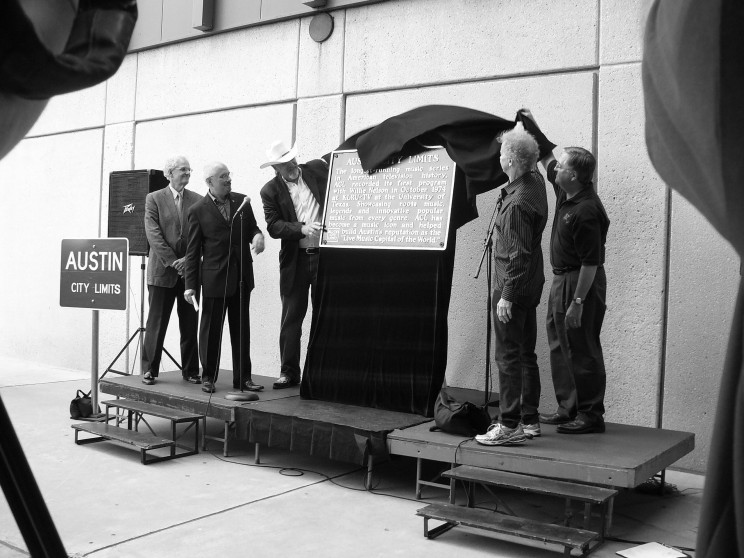
Unveiling the plaque designating Austin City Limits a music landmark by the Rock and Roll Hall of Fame.
Photo by Tracey E. W. Laird
-

Austin City Limits sign at ACL Live
Moody Theater in Austin, TX.
Photo by Ron Baker. CC BY-SA 3.0 via Wikimedia Commons
-

The entrance gate for the ACL Music Festival.
Shown here in 2009, promises a powerful experience.
Photo by Tracey E. W. Laird
-
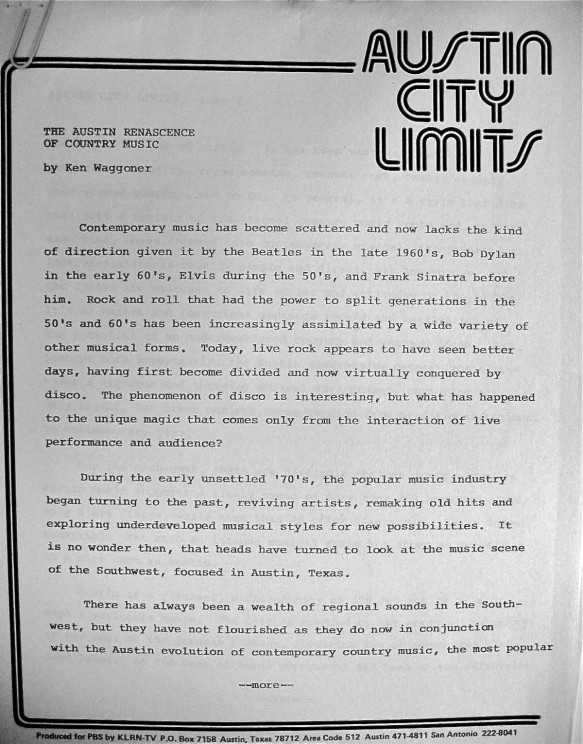
First of 5-page early press release that position Austin City Limits within the “Austin Renascence of Country Music.”
From Radio and Television, Folder 77, Austin City Limits, Southern Folklife Collection, The Wilson Library, University of North Carolina at Chapel Hill.
Photo by Tracey E. W. Laird
-
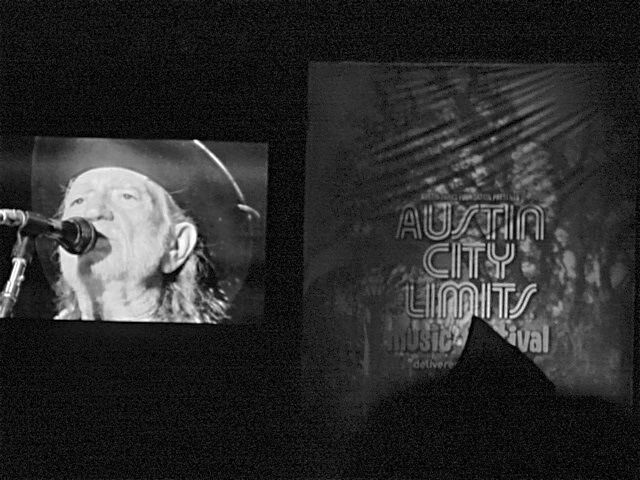
Willie Nelson performed on the television pilot for Austin City Limits in 1974 when the show was initially celebrating music like country, blues, and rock n’ roll. In 2014, he is still playing shows to tremendous crowds several football fields deep. Here his image is shown projected on the large screens to either side of the stage, at the 2006 ACL Music Festival. Photo by Tracey E. W. Laird
in 1974 when the show was initially celebrating music like country, blues, and rock n’ roll. In 2014, he is still playing shows to tremendous crowds several football fields deep. Here his image is shown projected on the large screens to either side of the stage, at the 2006 ACL Music Festival.
Photo by Tracey E. W. Laird
-
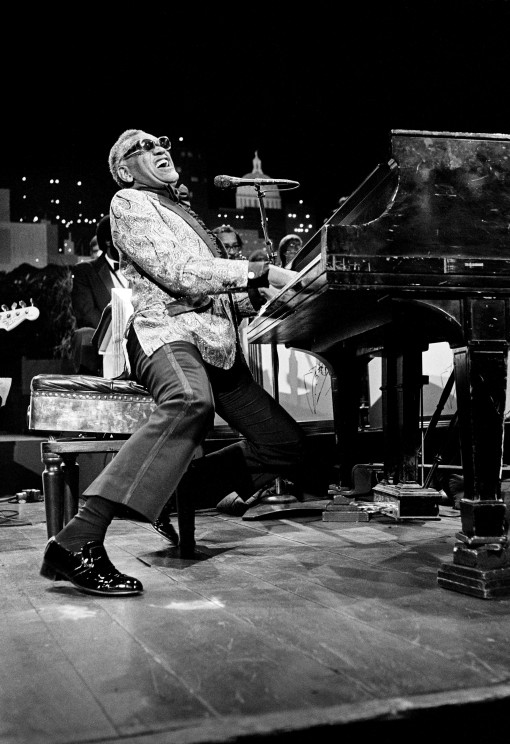
Scott Newton’s famous image of Ray Charles performing in 1984 on Austin City Limits.
Photograph by Scott Newton. Courtesy Austin City Limits/KLRU-TV.
-

Arcade Fire rehearses in Studio 6A on taping day.
Doug Robb practices shots on the ped cam to the left, Gary Menotti sits at his small round table with a stop watch out front, while Scott Newton studies the scene looking for angles of his own. Over the past decades, the music performed at ACL has evolved to include alternative rock artists like Arcade Fire, to rap and hip-hop artists like Eminem (who will be performing on the 2014 ACL Festival) and Mos Def.
Photo by Tracey E. W. Laird
-

In a photo taken during Mos Def’s rehearsal, the paint and lightbulbs screwed into the faux-Austin backdrop look so much different than they do on TV.
Photo by Tracey E. W. Laird
-

The crowd waits before a double taping for K’Naan and Mos Def in Studio 6A.
Terry Lickona is standing on the bleacher steps to the right in the photo.
Photo by Tracey E. W. Laird.
-

Matisyahu performing at the 2006 ACL Music Festival.
Photo by Tracey E. W. Laird
-

The audience out front takes in Gillian Welch and David Rawlings along with the new skyline backdrop.
Photo by Tracey E. W. Laird
-

Scott Newton photographed The Decemberists during their 2007 performance on Austin City Limits.
Photograph by Scott Newton. Courtesy Austin City Limits/KLRU-TV.
-

That same night, Newton also photographed Ghostland Observatory.
Photo by Scott Newton. Courtesy Austin City Limits/KLRU-TV.
-
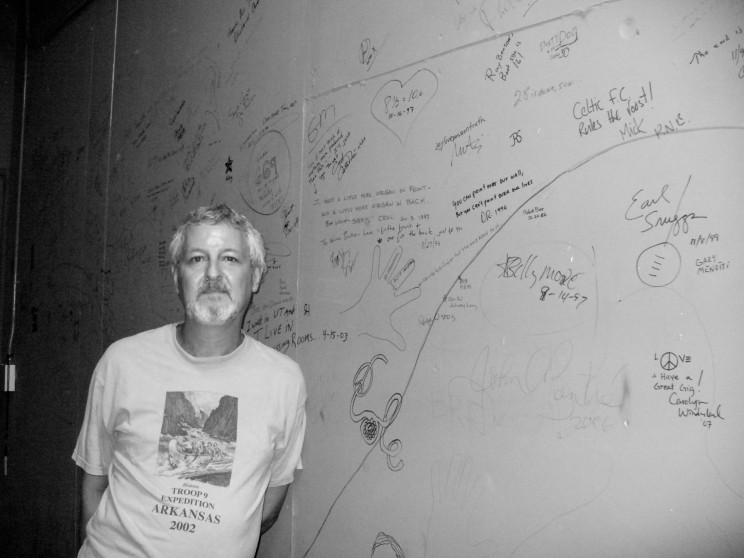
Longtime camera operator Robert Moorhead
stands before the Austin City Limits signing wall on the fifth floor of station KRLU, a memorial to a long-cherished tradition for staff members and artists.
Photo by Tracey E. W. Laird
-

“An intersection where places and sounds and people and images and words and ideas about...
…music take on intangible meanings, there lies the musical phenomenon Austin City Limits”—Tracey E. W. Laird. Austin City Limits Music Festival, 2009.
Photo by Steve Hopson, www.stevehopson.com. CC BY 3.0 via Wikimedia Commons
Featured image: Night view of Austin skyline and Lady Bird Lake as seen from Lou Neff Point. Photo by LoneStarMike. CC BY 3.0n via Wikimedia Commons.
The post Austin City Limits through the years appeared first on OUPblog.


By: Daniella Frangione,
on 9/20/2014
Blog:
OUPblog
(
Login to Add to MyJacketFlap)
JacketFlap tags:
Books,
History,
Biography,
president,
America,
roosevelt,
great depression,
fdr,
Franklin Delano Roosevelt,
Theodore Roosevelt,
slideshow,
Eleanor Roosevelt,
New Deal,
*Featured,
Images & Slideshows,
Add a tag
The Roosevelts: Two exceptionally influential Presidents of the United States, 5th cousins from two different political parties, and key players in the United States’ involvement in both World Wars. Theodore Roosevelt negotiated an end to the Russo-Japanese War and won the 1906 Nobel Peace Prize. He also campaigned for America’s immersion in the First World War. Almost 25 years later, Franklin Delano Roosevelt came into office during the calamitous aftermath of the Great Depression, yet during his 12-year presidency he contributed to the drop in unemployment rates from 24% when he first took office, to a staggering mere 2% when he left office in 1945. Furthermore, the first lady Eleanor Roosevelt encouraged discussion and implementation of women’s rights, World War II refugees, and civil rights of Asian and African Americans even well-after her husband’s presidency and death. Witness the lives of these illustrious figures through this slideshow, and take a look at the first half of 20th century American history through the lives of the Roosevelts.
-
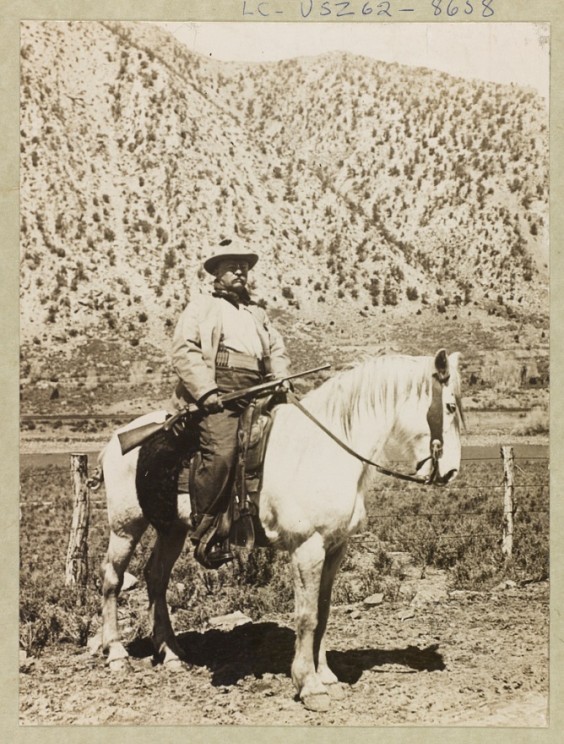
Theodore Roosevelt
“[Theodore] Roosevelt used his bully pulpit to shape public opinion on many subjects. Conservation of natural resources received special emphasis…. Earlier presidents had done little to protect scenic places and national parks against the wasteful exploitation of the environment…. The president achieved much, creating five national parks, four national game preserves, fifty-one bird reservations, and one hundred and fifty national forests” (Lewis L. Gould, Theodore Roosevelt, 43). Public domain via the Library of Congress
-

Theodore Roosevelt
In 1909 and 1910, after finishing his second term as president, Roosevelt traveled to Africa on safari. While abroad, the American public grew increasingly fascinated with Roosevelt and “to satisfy popular demand, [Theodore Roosevelt] recruited a friendly reporter, Warrington Dawson, to recount the progress of the hunt for the press corps. When Roosevelt returned first to Europe and then home in the spring of 1910, it was to intense popular acclaim everywhere.” (Lewis L. Gould, Theodore Roosevelt, 52). TR (center, facing sideways) on safari, 1910. Public domain via the Library of Congress.
-
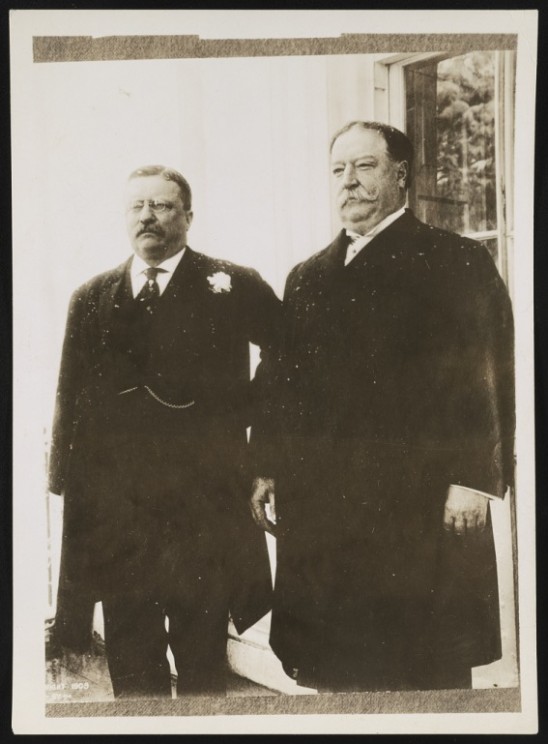
Theodore Roosevelt and William Howard Taft
“Taft was a first-class lieutenant; but he is only fit to act under orders; and for three years and a half the orders given him have been wrong. Now he has lost his temper and is behaving like a blackguard.” (Theodore Roosevelt to Arthur Lee, dated May 1912, from the Papers of Lord Lee of Fareham.) After leaving office in 1908, Theodore Roosevelt’s relationship with his personally-selected successor, William Howard Taft, soured due to policy differences. Theodore Roosevelt decided to run for an unprecedented third term against President Taft in 1912 as a third-party candidate. Theodore Roosevelt and his newly-founded Progressive Party were ultimately defeated by Democratic candidate Woodrow Wilson in the general election. Theodore Roosevelt and William H. Taft, c. 1909. Public domain via the Library of Congress.
-

Franklin Delano Roosevelt with his mother, Sara
“Franklin grew up in a remarkably cosseted environment, insulated from the normal experiences of most American boys, both by his family’s wealth and by their intense and at times almost suffocating love…. It was a world of extraordinary comfort, security, and serenity, but also one of reticence and reserve.” (Alan Brinkley, Franklin Delano Roosevelt, 4). Franklin Delano Roosevelt with his mother, Sara, 1887. Public domain via Wikimedia Commons.
-

FDR at Harvard
“Entering Harvard College in 1900, [FDR] set out to make up for what he considered his social failures [as a boarding school student at] Groton. He worked hard at making friends, ran for class office, and became president of the school newspaper, the Harvard Crimson, a post that was more a social distinction at the time than a journalistic one. (His own contributions to the newspaper consisted largely of banal editorials calling for greater school spirit.)” (Alan Brinkley, Franklin Delano Roosevelt, 5). FDR as president of the Harvard Crimson, with its Senior Board in 1904. Public domain via the Franklin Delano Roosevelt Library.
-

FDR and Polio
In August of 1921, Roosevelt fell ill after being exposed to the poliomyelitis virus. “He learned to disguise it for pulic purposes by wearing heavy leg braces; supporting himself, first with crutches and later with a cane and the arm of a companion; and using his hips to swing his inert legs forward…So effective was the deception that few Americans knew that Roosevelt could not walk” (Brinkley, Franklin Delano Roosevelt, 18-19). Franklin D. Roosevelt, Fala and Ruthie Bie at Hill Top Cottage in Hyde Park, N.Y . Franklin Delano Roosevelt Library.
-
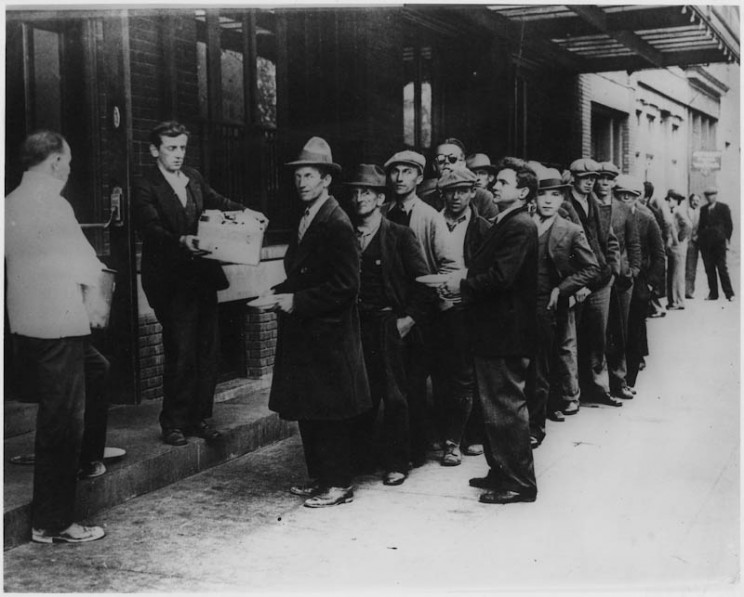
FDR and the Great Depression
Depression breadlines. In the absence of substantial Gov’t relief programs during 1932, free food was distributed with private funds in some urban centers to large numbers of the unemployed. February 1932 Franklin D. Roosevelt Presidential Library & Museum, Photo 69146. Public domain.
-
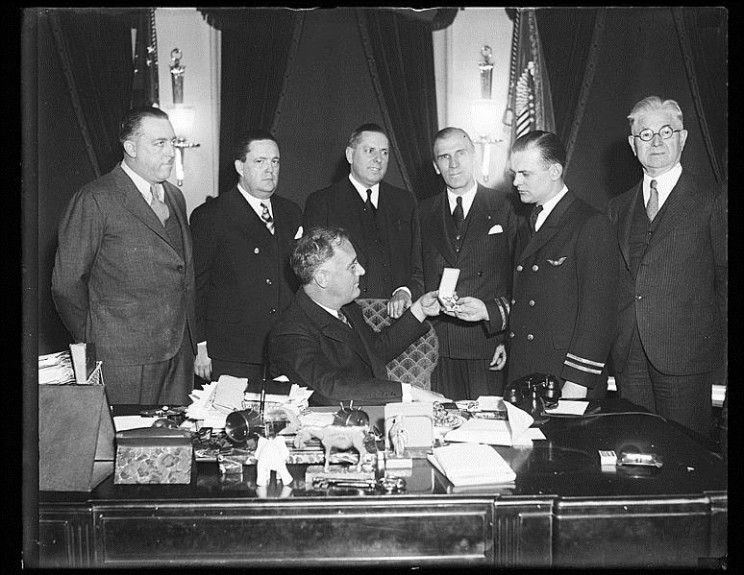
FDR and the New Deal
“When Franklin Delano Roosevelt took the oath of office as president for the first time on March 4, 1933, every moving part in the machinery of the American economy had evidently broken…. Roosevelt right away began working to repair finance, agriculture, and manufacturing…. The Roosevelt agenda grew by experiment: the parts that worked stuck, no matter their origin. Indeed, the program got its name by just that process: Roosevelt used the phrase “new deal” when accepting the democratic nomination for president, and the press liked it. The “New Deal” said the Roosevelt offered a fresh start, but it promised nothing specific: it worked, so it stuck.” (Rauchway, The Great Depression and the New Deal: A Very Short Introduction, 56). Franklin Roosevelt at desk in Oval Office with group, Washington, D.C. 1933. Library of Congress, Harris & Ewing Collection. Wikimedia Commons.
-
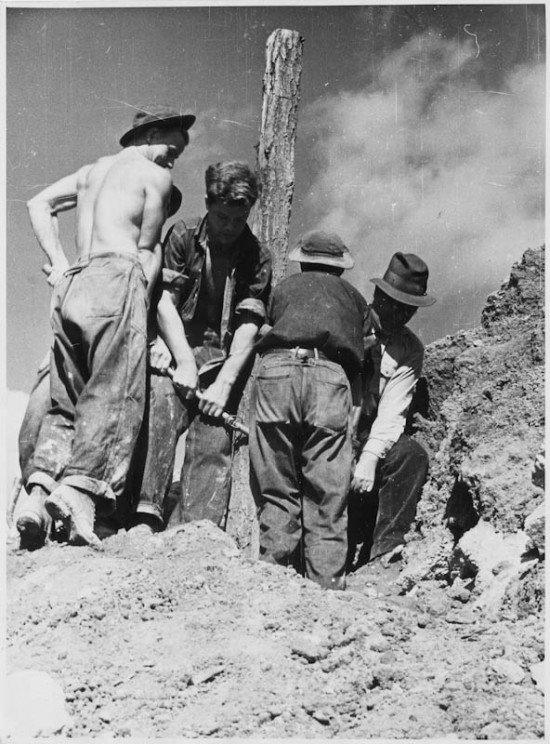
FDR and the New Deal
In the beginning of his presidency, Roosevelt proposed a “New Deal.” Over time, it “created state institutions that significantly and permanently expanded the role of federal government in American life, providing at least minimal assistance to the elderly, the poor, and the unemployed; protecting the rights of labor unions; stabilizing the banking system; building low-income housing; regulating financial markets; subsidizing agricultural production…As a result, American political and economic life became much more competitive, with workers, farmers, consumers, and others now able to press their demands upon the government in ways that in the past had usually been available only the corporate world” (Brinkley, Franklin Delano Roosevelt, 61). “CCC boys at work–Prince George Co., Virginia.” Franklin D. Roosevelt Presidential Library & Museum
-
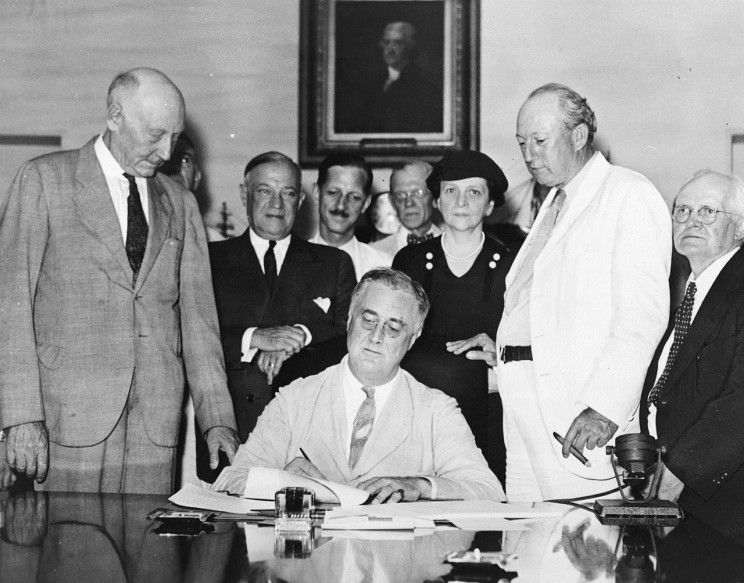
FDR and the Social Security ct
President Roosevelt signed the Social Security Act, at approximately 3:30 pm EST on August 14th, 1935. Standing with Roosevelt are Rep. Robert Doughton (D-NC); Sen. Robert Wagner (D-NY); Rep. John Dingell (D-MI); Rep. Joshua Twing Brooks (D-PA); the Secretary of Labor, Frances Perkins; Sen. Pat Harrison (D-MS); and Rep. David Lewis (D-MD). Library of Congress. Wikimedia Commons.
-

FDR and the Social Security Act
One of the most important pieces of social legislation in American History was The Social Security Act of 1935. The Act was part of Roosevelt’s Second New Deal (from 1935-38). The Social Security Act set up several important programs, including unemployment compensation (funded by employers) and old-age pensions (funded by a Social Security tax paid jointly by employers and employees). It also provided assistance to the disabled (primarily the blind) and the elderly poor (people presumably too old to work). Furthermore, it established Aid to Dependent Children (later called Aid to Families with Dependent Children, or AFDC), which created the model for what most Americans considered “welfare” for over sixty years (Brinkley, Franklin Delano Roosevelt, 51-52). Roosevelt said, “No one can guarantee this country against the dangers of future depressions, but we can reduce those dangers” (Kennedy, Freedom from Fear, 270). This is a poster publicizing Social Security benefits. Public Domain via Franklin D. Roosevelt Library.
-

FDR and the Second World War
When war finally broke out in Europe in September 1939, Roosevelt continued to insist that the conflict would not involve the United States. Roosevelt declared, “This nation will remain a neutral nation, but I cannot ask that every American remain neutral in thought as well.” Then, on December 7th, 1941, a wave of Japanese bombers struck the American naval base in Pearl Harbor, Hawaii, killing more than 2,000 American servicemen and damaging or destroying dozens of ships and airplanes. Roosevelt called it, “a date which will live in infamy” (Brinkley, Franklin Delano Roosevelt, 68). View looking up “Battleship Row” on 7 December 1941, after the Japanese attack on Pearl Harbor. The battleship USS Arizona (BB-39) is in the center, burning furiously. To the left of her are USS Tennessee (BB-43) and the sunken USS West Virginia (BB-48). Official U.S. Navy Photograph. Wikimedia Commons.
-
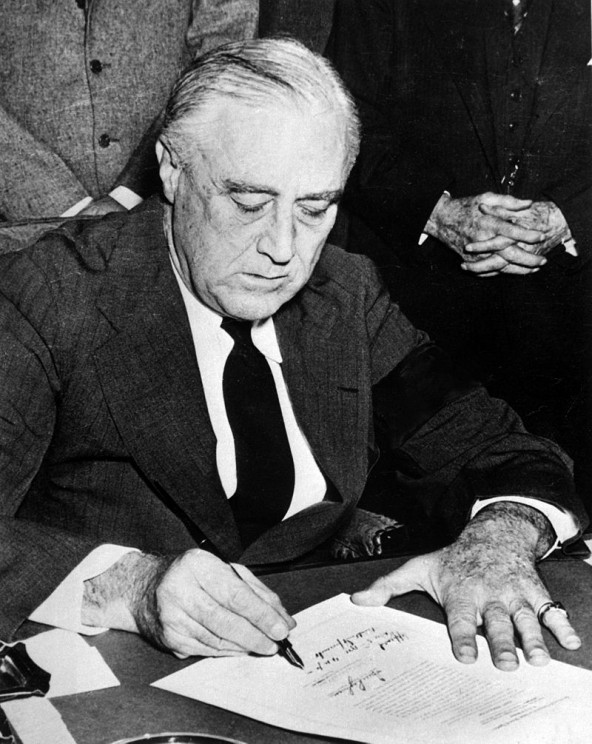
FDR and the declaration of war
“The Senate and House voted for a declaration of war—the Senate unanimously, and the House by a vote of 388 to 1. Three days later, Germany and Italy, Japan’s European allies, declared war on the United States, and the American Congress quickly and unanimously reciprocated” (Brinkley, Franklin Delano Roosevelt, 75-76). United States President Franklin D. Roosevelt signing the declaration of war against Japan, in the wake of the attack on Pearl Harbor. US National Parks Service via Wikimedia Commons
-
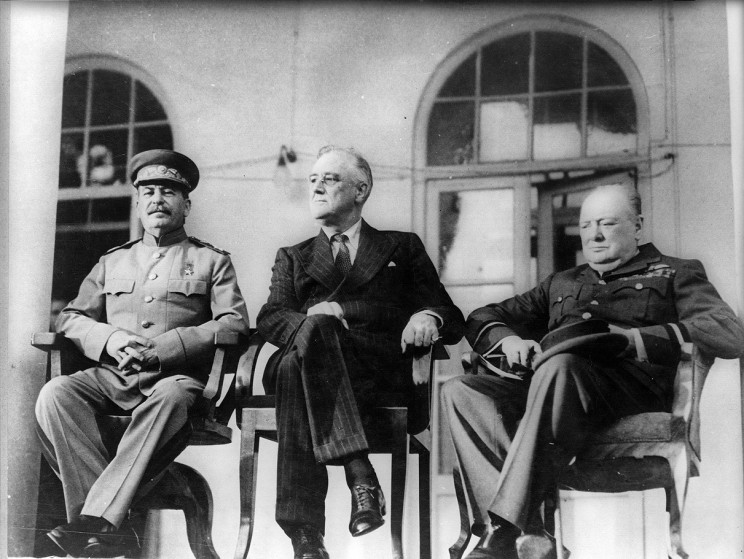
The Big Three
Shown here are ‘The Big Three’: Stalin, U.S. President Franklin D. Roosevelt, and British Prime Minister Winston Churchill at the Tehran Conference, November 1943. At this time, war in eastern Europe had turned decisively in favor of the Soviety Union, which meant that Roosevelt and Churchill now had little leverage over Stalin. Even so, Stalin agreed to enter the Pacific war after the fighting in Europe came to an end. Roosevelt and Churchill promised to launch the long-delayed invasion of France in the spring of 1944 (Brinkley, Franklin Delano Roosevelt, 83). US Signal Corps public domain photo.
-
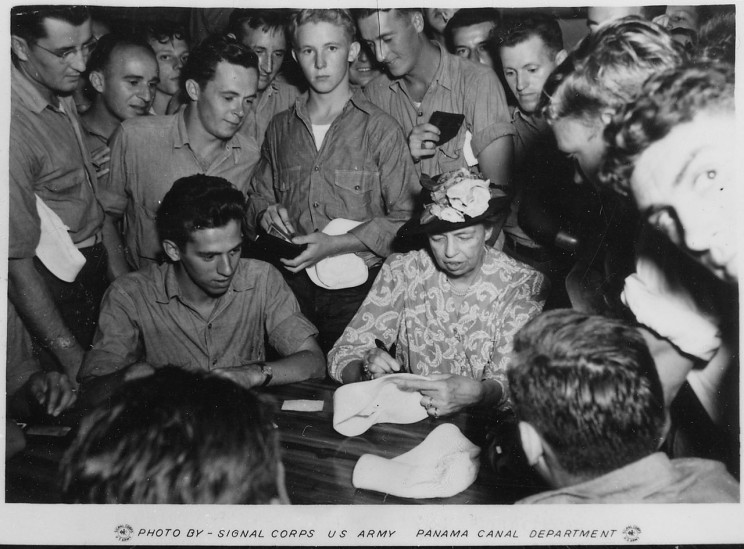
Eleanor Roosevelt and the Second World War
An outspoken and publicly active First Lady, Eleanor Roosevelt was active both on the homefront and overseas. Her visits drew crowds of people and welcomed her favorably and amiably. This resulted in positive press being written about the Roosevelts across the United States as well as Britain. Eleanor Roosevelt visiting troops in Galapagos Island. US National Archives and Records Administration
-
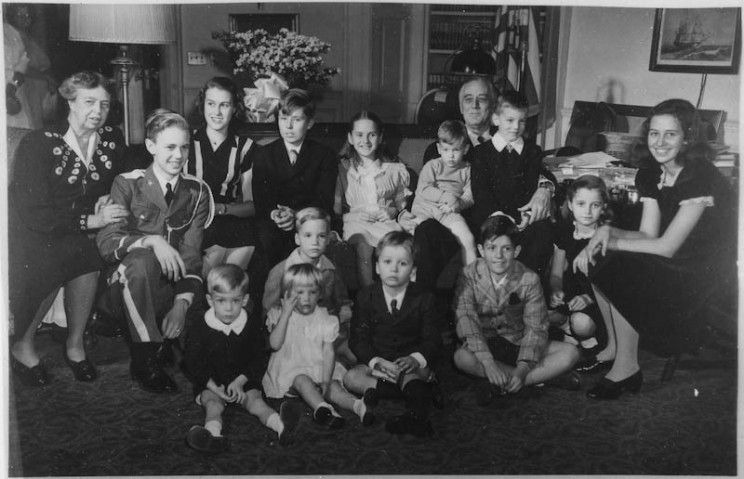
The Roosevelt Family
Franklin D. Roosevelt and Eleanor Roosevelt with their 13 grandchildren in Washington, D.C. in January of 1945 (Archivist note: This photograph was taken at FDR’s fourth inauguration. This is one of the last family photographs taken before FDR’s death.) Franklin D. Roosevelt Presidential Library & Museum.
-
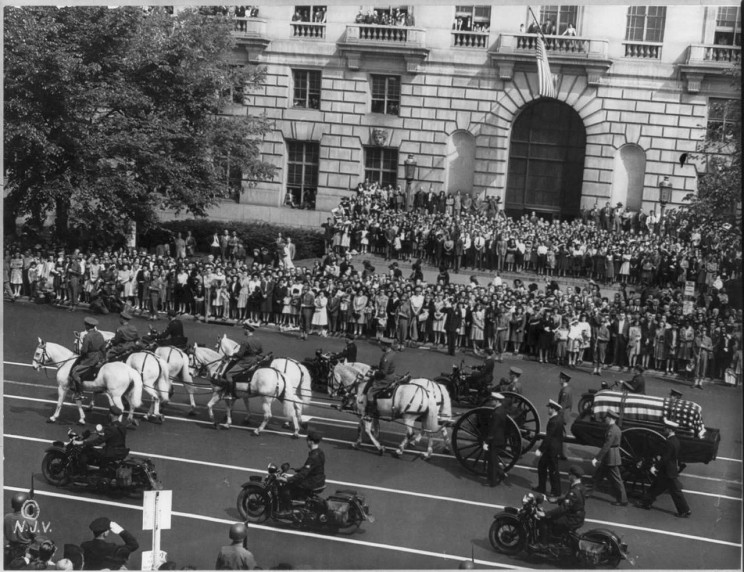
FDR's death
Franklin Delano Roosevelt died of a stroke in on 12 April 1945. In the decades since his death, his stature as one of the most important leaders of the twentieth century has not diminished. “History will honor this man for many things, however wide the disagreement of many of his countrymen with some of his policies and actions,” the New York Times wrote the day after his death. “It will honor him above all else because he had the vision to see clearly the supreme crisis of our times and the courage to meet that crisis boldly. Men will thank God on their knees, a hundred years from now, that Franklin D. Roosevelt was in the White House” (The New York Times, 13 April 1945). Roosevelt’s funeral procession in Washington in 1945; watched by 300,000 spectators. Library of Congress.
-
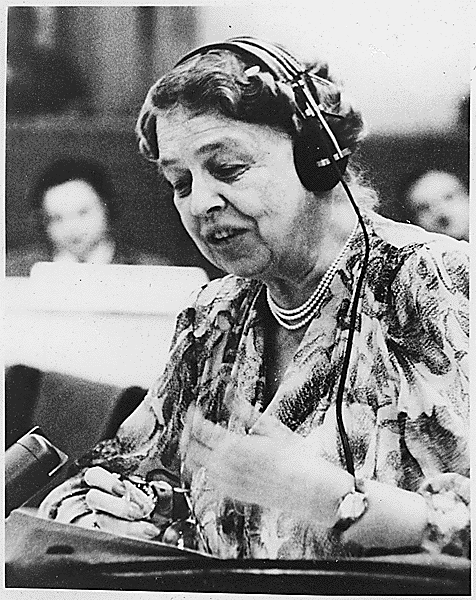
Eleanor Roosevelt
The remaining 17 years that Eleanor Roosevelt lived after her husband passed away were years in which she carried out her humanitarian efforts and maintained the integrity of the Roosevelt name. The next President Harry Truman appointed Eleanor as a delegate to the United Nations General Assembly, and less than a year later, she became the first chairperson of the preliminary United Nations Commission on Human Rights. She also chaired the John F. Kennedy administration’s Presidential Commission on the Status of Women. To this day, she is quoted, and referred to with great respect and admiration for her efforts in human rights and politics. Roosevelt speaking at the United Nations in July 1947. Franklin D. Roosevelt Presidential Library and Museum.
Headline image credit: The Roosevelt Family. Library of Congress. The post A visual history of the Roosevelts appeared first on OUPblog.


By: AlyssaB,
on 8/25/2014
Blog:
OUPblog
(
Login to Add to MyJacketFlap)
JacketFlap tags:
Books,
History,
Religion,
american history,
America,
cartography,
Humanities,
*Featured,
maps,
hell,
slideshow,
religion in america,
Damned Nation,
Hell in America from the Revolution to Reconstruction,
Kathryn Gin Lum,
purgatory,
Add a tag
Antebellum Americans were enamored of maps. In addition to mapping the United States’ land hunger, they also plotted weather patterns, epidemics, the spread of slavery, and events from the nation’s past.
And the afterlife.
Imaginative maps to heaven and hell form a peculiar subset of antebellum cartography, as Americans surveyed not only the things they could see but also the things unseen. Inspired by the biblical injunction to “Enter ye in at the strait gate: for wide is the gate, and broad is the way, that leadeth to destruction… and narrow is the way, which leadeth unto life, and few there be that find it” (Matthew 7:13-14 KJV), the maps provided striking graphics connecting beliefs and behavior in this life to the next.
-
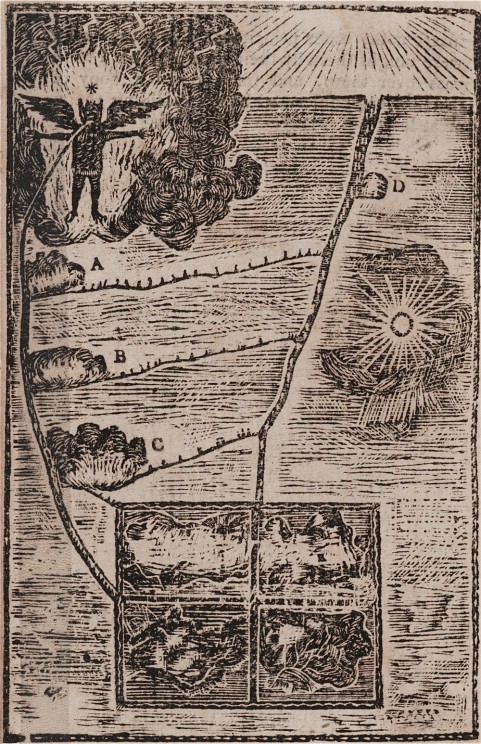
“Mah-tan’-tooh, or the Devil, standing in a flame of fire, with open arms to receive the wicked.”
As early as the 17th century, Catholic missionaries were using didactic visuals of heaven and hell to surmount a language barrier with indigenous North Americans. Such illustrations probably influenced the cosmological map of Neolin, the Delaware Prophet. Born around 1762 near Lake Erie, Neolin experienced a series of otherworldly visions that he turned into a map for his followers. The image here, copied by a white observer, was published some years later in a volume of captivity narratives. The rectangle at the bottom of the map represented the earth and its inhabitants. Those who avoided temptation would proceed directly to future bliss on the path labeled “D,” while those who followed paths A, B, and C would undergo various purgation processes before receiving their reward. The wicked, on the bottom left of the rectangle, would go straight to a fiery hell guarded by the Devil. Neolin warned his followers that the vices Europeans brought, like alcohol consumption, had made the path to future bliss more perilous.
Credit: In Archibald Loudon, A selection, of some of the most interesting narratives, of outrages, committed by the Indians, in their wars, with the white people… (Carlisle [Pa.]: From the press of A. Loudon (Whitehall), 1808-1811). Monroe Wakeman and Holman Loan Collection of the Pequot Library Association, on deposit in the Beinecke Rare Book and Manuscript Library, Pequot L92. Courtesy of the Beinecke Rare Book and Manuscript Library.
-

Catholic Ladder
Like earlier didactic devices, this Catholic Ladder (ca. 1840) was created by a French Catholic missionary for the purpose of evangelization. First carved into a large wooden stick, and then painted on a paper scroll measuring nearly five feet long, the Catholic Ladder served as a visual aid for Father Francis Norbert Blanchet and his associates to explain sacred history to the indigenous people of the Pacific Northwest. Blanchet drew bars to represent the passage of centuries and dots to represent years in the life of Christ, and added simple pictures to illustrate sacred events. There is no sign of heaven or hell in this ladder, which simply ends with Blanchet’s mission in the present day. But this wasn’t just a neutral timeline: for Blanchet, there clearly is a wrong path to follow. In the detail shown here, Blanchet depicted the Protestant Reformation as a spindly branch off the main course of sacred history, with the three bars below it representing Luther, Calvin, and Henry VIII.
Credit: By Fr. Francis Norbert Blanchet, ca. 1840. 6 1/2 x 58 in. Section from middle of ladder, showing the Crucifixion to the Protestant Reformation. Courtesy of The Oregon Historical Society, Image Number OrHi 89315.
-

Protestant Ladder
Protestant missionaries Henry and Eliza Spalding, who also traveled to the Pacific Northwest, responded to the Catholic depiction of Reformation heroes with a ladder of their own. Six feet long and two feet wide, the ladder made explicit the biblical teaching about the wide and narrow paths. Painted by Eliza with ink and colored dyes made from berries and natural pigments, the ladder, like Blanchet’s, also illustrated sacred history beginning with Adam and Eve. But it divided this history into the good and the bad, and instead of ending in the present, it ended with the reward of the righteous and the punishment of the wicked. On the right (directionally and morally) path to heaven, the Spaldings included Moses, Paul, and Martin Luther. On the left and wider path to hell, they featured the Tower of Babel, the beheading of John the Baptist, and several scenes with the Pope, culminating with his headfirst fall into a fiery hell where a horned devil awaits.
Credit: By Henry H. and Eliza Spalding, ca. 1845. Section from top of ladder. Courtesy of The Oregon Historical Society, Image Number OrHi 87847.
-
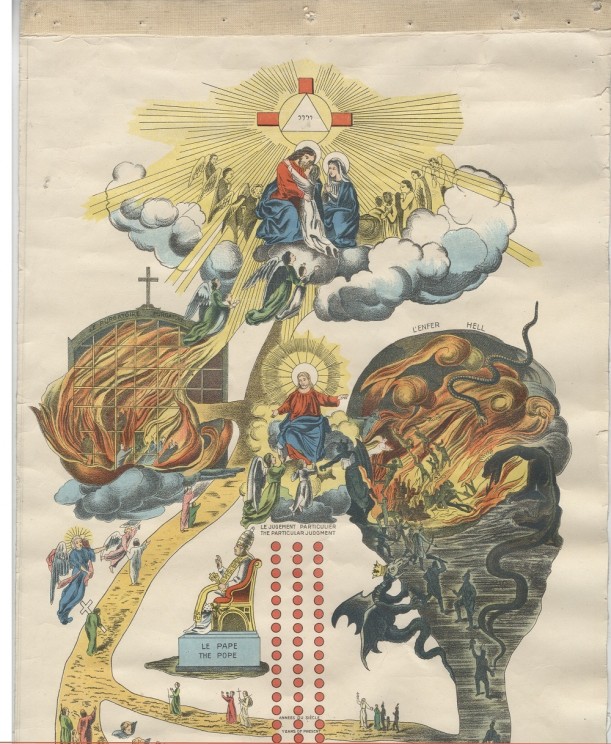
Tableau-catéchisme/Pictorial catechism
If the colorful and dramatic Protestant Ladder was more visually exciting than Blanchet’s monochrome series of bars and dots, Albert Lacombe’s mass-produced version from the 1870s was even more so. Lithography techniques had improved by this time, making it possible to make tens of thousands of copies of the striking six foot by one foot scroll. Like the Spaldings, Lacombe embellished the idea of the two roads to heaven and hell, but his was a Catholic version that included a fiery Purgatory on the path to heaven. And, where the Spaldings had the Pope falling into the flames of hell, Lacombe featured the richly-clad Pope on a gilded throne, pointing the way to heaven. No surprise that the Pope himself endorsed the ladder, which saw use among Catholic missionaries worldwide.
Credit: By Reverend Albert Lacombe, O.M.I., 1874. Purgatory to the left, hell to the right, heaven above. Original at Missionary Oblates, Grandin Province Archives at the Provincial Archives of Alberta. Printed on four pasted panels glued together and backed with linen, attached to a stick, and rolled like a scroll. Electronic image courtesy of the Department of Special Collections and University Archives, Marquette University Libraries.
-
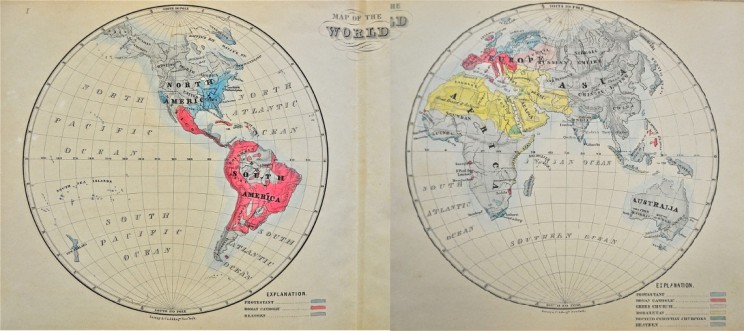
Frontispiece in John Cameron Lowrie, A Manual of Missions, or, Sketches of the Foreign Missions of the Presbyterian Church
On the face of it, this is not a guide to heaven or hell. It is a detailed map of the world, so rooted in the here-and-now that it is meticulously plotted along latitude and longitude. It seems fairly neutral at first glance. But the color-coded key tells a more partisan story. Each region of the world is colored according to religion. For John Cameron Lowrie, the corresponding secretary of the Presbyterian Board of Foreign Missions, only the blue of Protestantism was salvific. The didactic moral of the map? Live in or move to a blue zone, and help to color the rest of the world blue by converting its inhabitants to Protestantism and hence saving them from eternal damnation.
Credit: Photograph by Nicholas Lum.
-
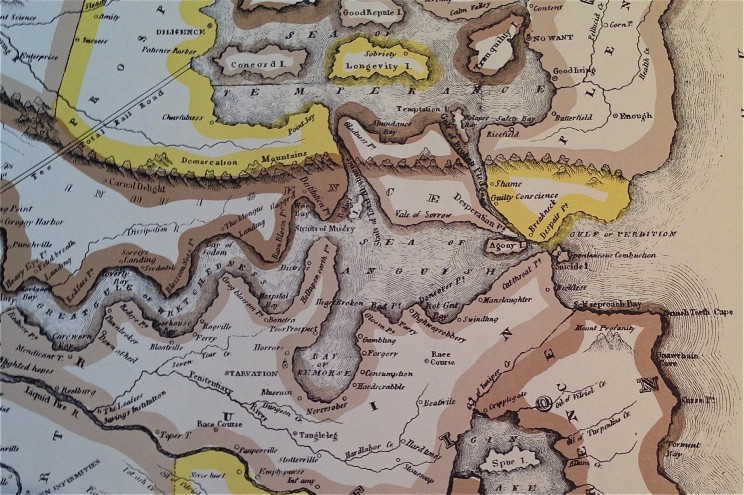
Temperance Map
The nineteenth-century temperance movement in the US sought to curtail alcohol consumption in a nation where it was widespread. Its reach extended to Hawaii, where sailors boozed in port towns and alcohol made its way to the indigenous population. At Lahainaluna Seminary on the island of Maui, Hawaiian students produced this Temperance Map, which depicted the ruinous consequences of alcohol and the rewards of temperance. They also printed a simplified version of the map in Hawaiian. Unlike the ladders, which showed fairly straightforward roads to heaven or hell, the temperance maps offered a tangle of choices that could lead in multiple directions. Viewers were cautioned to exercise constant vigilance. Even if one was happily floating on the Sea of Temperance, making stops at the isles of Longevity and Tranquility, the map showed how easy it was to get swept into Relapse Bay and the Gulf of Broken Pledges. And from there, the Gulf of Perdition was just one wrong turn away.
Credit: by C. Wiltberger Jr. (Published by L. Andrews, Lahainaluna, Maui, Republished in 1972 by the Hale Pa’i Printing Museum of the Lahaina Restoration Foundation, Lahainaluna, Lahaina, Hawaii, 96761). Photograph by author from personal copy. Detail shows the “Sea of Anguish” in the center and the “Sea of Temperance” above it, connected by the “Strait of Total Abstinence” and the “Gulf of Broken Pledges,” which also leads to the “Gulf of Perdition” to the right.
The post The road to hell is mapped with good intentions appeared first on OUPblog.


By: Alice,
on 8/17/2014
Blog:
OUPblog
(
Login to Add to MyJacketFlap)
JacketFlap tags:
Books,
advocacy,
Law,
Current Affairs,
slideshow,
*Featured,
Images & Slideshows,
higher education law,
Judge Gratwicke,
mooting competition,
national mooting competition,
OUP and BPP motting competition,
undergraduate law,
Add a tag
Oxford University Press and BPP Law School are proud to co-sponsor this national mooting competition which provides law students from around the country with the opportunity to practise and hone their advocacy skills. The event is now one of the most prestigious mooting competitions in the UK, where student advocates debate a fictitious case in a mock court of appeal in front of a judge. Over 140 law students embark on the contest each October; run on a knock-out basis they are whittled down over 4 rounds to the 4 who compete in the nail-biting final.
The final of the OUP and BPP National Mooting Competition 2013-2014 took place on Thursday 10th July, and proved to be a very enjoyable night of mooting indeed. Teams from Aston University, the London School of Economics, Kaplan Law School and Queen Mary, University of London battled it out for the top prize, with Theodore Anthony Meddick Dyson and Darren Low of Queen Mary, University of London emerging as worthy moot champions.
His Honour Judge Charles Gratwicke of Chelmsford Crown Court presided over the final and kept the students on their toes with some keen questioning. In his summing up, Judge Gratwicke praised the hard work and depth of knowledge the students demonstrated, saying: “You have displayed an exceptionally high standard of advocacy skills and the differences between the teams are paper-thin. You will all be successful because people of quality always find their niche”.
-

Preparing for the competition
An audience member at the final of the OUP and BPP National Mooting Competition 2013-2014.
-
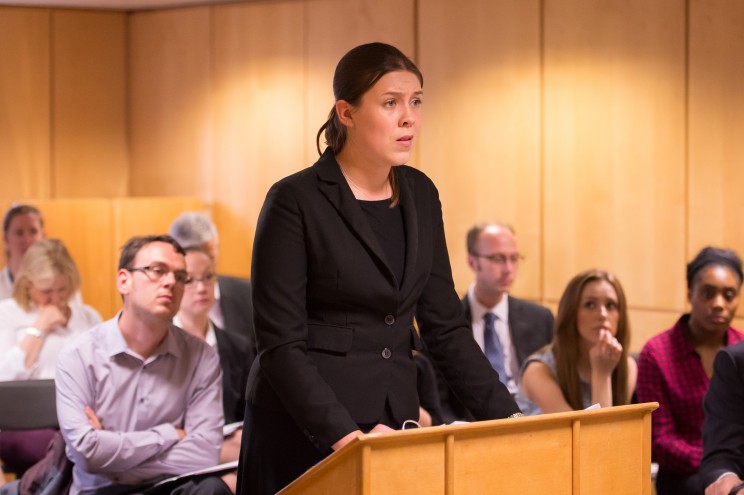
Lorna Badham (Kaplan Law School)
Lorna Badham (Kaplan Law School) presenting her submissions to the Mooting final.
-

His Honour Judge Gratwicke
His Honour Judge Gratwicke presiding over the second moot of the evening.
-

Competition notes
A trial bundle prepared by a competitor for the moot.
-

Gerard Pitt (Kaplan Law School)
Respondents from Queen Mary University of London watch as Gerard Pitt (Kaplan Law School) delivers his submissions
-
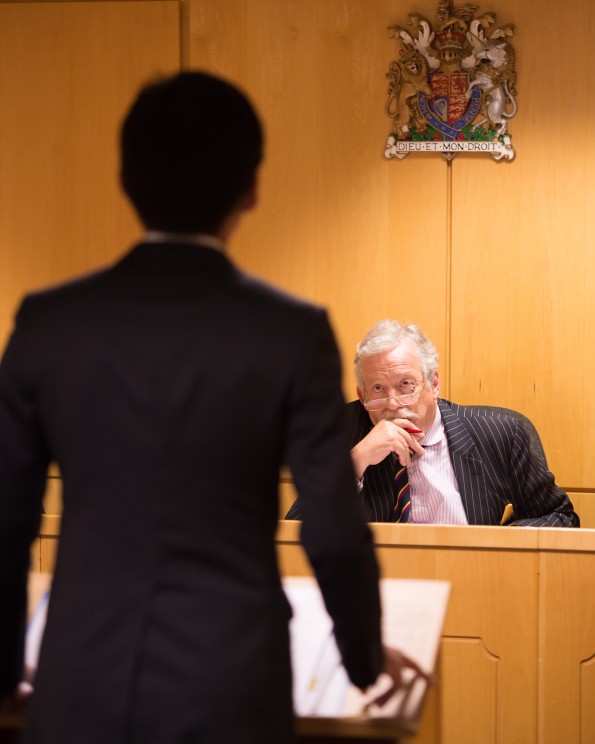
Darren Low (Queen Mary)
Junior counsel for Queen Mary, Darren Low, faces His Honour Judge Gratwicke
-

The moot court
The moot court in session with Darren Low facing His Honour Judge Gratwicke
-

Drinks reception
The attendees at the drinks reception
-

Malvika Jaganmohan (LSE)
Malvika Jaganmohan (LSE) talks with friends after the moot
-

Adam Shaw-Mellors (Aston University)
Senior counsel from Aston University, Adam Shaw-Mellors, awaits the result
-

Awaiting the result
Friends and family watch on as His Honour Judge Gratwicke announces the winners
-

-

The winners
The 2014 winners from Queen Mary, Darren Low and Theodore Anthony Meddick Dyson, with His Honour Judge Gratwicke
All photos by Arnaud Stephenson.
The post The OUP and BPP National Mooting Competition appeared first on OUPblog.


By: Alice,
on 8/7/2014
Blog:
OUPblog
(
Login to Add to MyJacketFlap)
JacketFlap tags:
Books,
mythological creatures,
odyssey,
athena,
the odyssey,
gods,
powell,
slideshow,
barry,
Humanities,
Homer,
Odysseus,
puppeteers,
*Featured,
Images & Slideshows,
Classics & Archaeology,
OUP USA HE,
Barry B. Powell,
OUP USA Higher Ed,
odysseus’s,
charbidis,
Add a tag
The gods and various mythological creatures — from minor gods to nymphs to monsters — play an integral role in Odysseus’s adventures. They may act as puppeteers, guiding or diverting Odysseus’s course; they may act as anchors, keeping Odysseus from journeying home; or they may act as obstacles, such as Cyclops, Scylla and Charbidis, or the Sirens. While Gods like Athena are generally looking out for Odysseus’s best interests, Aeolus, Poseidon, and Helios beg Zeus to punish Odysseus, but because his fate is to return home to Ithaca, many of the Gods simply make his journey more difficult. Below if a brief slideshow of images from Barry B. Powell’s new free verse translation of Homer’s The Odyssey depicting the god and other mythology.
-
Kirkê
http://blog.oup.com/wp-content/uploads/2014/08/Picture13.png
Kirkê is the goddess of magic, also referred to as a witch or enchantress. Odysseus’ arrival to her island is described as follows, “the house of Kirkê, made of polished stone, in an open meadow. There were wolves around it from the mountains, and lions whom Kirkê had herself enchanted by giving them potions” (10.197-199). When several of Odysseus’ men enter through her doors, she turns them into “beings with the heads of swine, and a pig’s snort and bristles and shape, but their minds remained the same” (10.225-227). However, Odysseus receives assistance from Hermes when he is given a powerful herb that wards off the effect any of Kirke’s potions. Odysseus stays with her for one year, and then decides that he must go back home to Ithaca. As mentioned previously, Kirkê tells him that he must sail to Hades, the realm of the dead, to speak with the spirit of Tiresias.
Kirkê Offering the Cup to Ulysses by John William Waterhouse. 1891. Oil on canvas. Dimensions 149 cm × 92 cm (59 in × 36 in). Gallery Oldham, Oldham.
-
Kalypso
http://blog.oup.com/wp-content/uploads/2014/08/Picture12.jpg
Shipwrecked from the storm that Zeus conjures up to punish him, Odysseus manages to float over to Ogygia where he encounters the nymph and beautiful goddess Kalypso with whom Odysseus embarks on a seven-year relationship with. She is a nymph, or a nature spirit, who acts as a barrier between Odysseus fulfilling his destiny and returning home to Ithaca. In Book 5, Athena says to Zeus, “he lies on an island suffering terrible pains in the halls of great Kalypso, who holds him against his will. He is not able to come to the land of his fathers” (5.12-14).
Kalypso receiving Telemachos and Mentor in the Grotto detail by William Hamilton. 18th century.
-
Helios
http://blog.oup.com/wp-content/uploads/2014/08/Picture11.jpg
Odysseus and his men take refuge on the island of Thrinacia (the island of the sun) during their journey. They remain there for a month, but the crew's provisions eventually run out, and Odysseus' crew members slaughter the cattle of the Sun. When the Sun god (Helios) finds out, he asks Zeus to punish Odysseus and his men. Helios demands, “If they do not pay me a suitable recompense for the cattle, I will descend into the house of Hades and shine among the dead!” (12.364-366). Zeus agrees and strikes Odysseus’ ship with lightning and kills all of Odysseus’ crew members.
Head of Helios, middle Hellenistic period. Holes on the periphery of the cranium are for inserting the metal rays of his crown. The characteristic likeness to portraits of Alexander the Great alludes to Lysippan models. Archaeological Museum of Rhodes.
-
Herakles
http://blog.oup.com/wp-content/uploads/2014/08/Picture10.png
Odysseus and Herakles meet in the Underworld, and also encounters Herakles’ daughter Megara and mother Amphitryon. Odysseus recalls seeing Herakles and says, “Herakles was like the dark night, holding his bare bow and an arrow on the string, glaring dreadfully, a man about to shoot. The baldric around his chest was awesome—a golden strap in which were worked wondrous things, bears and wild boars and lions with flashing eyes, and combats and battles and the murders of men. I would wish that the artist did not make another one like it!” (11.570-576).
Herakles crowned with a laurel wreath, wearing the lion-skin and holding a club and a bow, detail from a scene representing the gathering of the Argonauts. From an Attic red-figure calyx-krater, ca. 460–450 BC. From Orvieto (Volsinii).
-
Ino (Leucothea)
http://blog.oup.com/wp-content/uploads/2014/08/Picture9.jpg
Shipwrecked after Poseidon sinks his ship, Odysseus encounters Ino (Leucothea) who takes pity on him. She leads him toward the land of the Phaeacians and says, “Here, take this immortal veil and tie it beneath your breast. You need not fear you will suffer anything. And when you get hold of the dry land with your hands, untie the veil and throw it into the wine-dark sea, far from land. Then turn away” (5.320-324).
Leucothea (1862), by Jean Jules Allasseur (1818-1903). South façade of the Cour Carrée in the Louvre palace, Paris.
-
Aiolos
http://blog.oup.com/wp-content/uploads/2014/08/Picture8.jpg
In Book 10, The Achaeans sail from the land of the Cyclops to the home of Aiolus, ruler of the winds. He gifts Odysseus with a bag containing all of the winds in order to guide Odysseus and his crew home. However, the winds escape from the bag due to Odysseus’ men believing that the bag contains gold and silver, and end up bringing Odysseus and his men back to Aiolia. Aiolos provides Odysseus with no further help from then on, as he says, “It is not right that I help or send that man on his way who is hated by the blessed gods” (10.72-73). This is to say that Aiolos judges Odysseus’ return as a bad omen.
This image is a Roman mosaic from the House of Dionysos and the Four Seasons, 3rd century AD, Roman city of Volubilis, capital of the Berber king Juba II (50 BC-24 AD) in the province of Mauretania, Morocco. The Romans loved to decorate their floors with themes taken from Greek myth, and many have survived.
-
Picture7
http://blog.oup.com/wp-content/uploads/2014/08/Picture7.png
Athena is the most influential goddess, and a catalyst for the events in the story the Odyssey. She is not only the goddess of wisdom, but also of strategy, law and justice, and inspiration among others, and is referred to consistently in the book as “flashing-eyed Athena.” At times in Homer’s epic poem, she acts as a puppeteer throughout Odysseus’ journey as she guides his movements and modifies his and her own appearance to accommodate Odysseus’ circumstances advantageously.
Marble, Roman copy from the 1st century BC/AD after a Greek original of the 4th century BC, attributed to Cephisodotos or Euphranor. Related to the bronze Piraeus Athena.
-
Aphrodite and Ares
http://blog.oup.com/wp-content/uploads/2014/08/Picture6.jpg
Referred to as the “godlike” visitor, Odysseus is honored during a Phaeacian celebration hosted by Nausicaä’s parents. During the ceremony, a poet named Demdokos plays a song on his lyre, “the love song of Ares and fair-crowned Aphrodite, how they first mingled in love, in secret, in the house of Hephaistos” (8.248-250).
The adultery of Ares and Aphrodite. Clad only in a gown that comes just above her pubic area, Aphrodite holds a mirror while her half-naked lover, Ares, sitting on a nearby bench, embraces her and touches her breast. The device that imprisoned them is visible as a cloth stretched above their heads. Such paintings were especially popular in Roman brothels in Pompeii. Roman fresco from Pompeii, c. AD 60.
-
Artemis
http://blog.oup.com/wp-content/uploads/2014/08/Picture5.jpg
Approaching the Phaeacian princess Nausicaä for the first time, Odysseus asks, “are you a goddess, or a mortal? If you are a goddess, one of those who inhabit the broad heaven, I would compare you in beauty and stature and form to Artemis, the great daughter of Zeus” (6.139-142).
Wearing an elegant dress and a band about her hair, Artemis carries a torch in her left hand and a dish for drink offerings in her right hand (phialê), not her usual attributes of bow and arrows. She is labeled POTNIAAR, “lady Artemis.” An odd animal, perhaps a young sacrificial bull, gambols at her side. Athenian white-ground lekythos, c. 460-450 BC, from Eretria.
-
Poseidon
http://blog.oup.com/wp-content/uploads/2014/08/Picture4.jpg
Poseidon holding a trident. Poseidon is the Greek god of the Sea, or as referred to in the epic poem, “the earth-shaker.” The god is long haired and bearded and wears a band around his head. The trident may in origin have been a thunderbolt, but it has been changed into a tuna spear. Corinthian plaque, from Penteskouphia, 550–525 BC. Musée du Louvre, CA 452
-
Hades
http://blog.oup.com/wp-content/uploads/2014/08/Picture3.png
When Odysseus is on the witch-goddess Kirkê’s island (discussed later), she tells him that he must sail to Hades, the realm of the dead, to speak with the spirit of Tiresias. The underworld is described by Odysseus as a place where “total night is stretched over wretched mortals” (11.18-19). While we do not meet the god Hades directly, his realm is explored by Odysseus. During his time spent in the underworld, Odysseus meets many different people who he had met or been directly influenced by at different points in his life, including his former shipmate Elpenor, his mother Anticleia, and warriors such as Agamemnon, Achilles, Ajax, Minos, Orion, and Heracles.
Hades with Cerberus (Heraklion Archaeological Museum)
-
Hermes
http://blog.oup.com/wp-content/uploads/2014/08/Picture2.jpg
Hermes weighing souls (psychostasis). In Book 5, Hermes, messenger of the gods, is sent to tell the nymph Kalypso to allow Odysseus to leave so he can return home after several years of being detained on the island of Ogygia. Hermes is also known as the god of boundaries, and as such he is Psychopompos, or “soul-guide”: He leads the souls of the dead to the house of Hades. In a sense, Odysseus is dead, imprisoned on an island in the middle of the sea by Kalypso, the “concealer.” Here the god is shown with winged shoes (in Homer they are “immortal, golden”) and a traveler’s broad-brimmed hat, hanging behind his head from a cord. In his left hand he carries his typical wand, the caduceus, a rod entwined by two copulating snakes. In his right hand he holds a scale with two pans, in each of which is a psychê, a “breath-soul” represented as a miniature man (scarcely visible in the picture). Athenian red-figure amphora from Nola, c. 460 BC, by the Nikon Painter.
-
Zeus
http://blog.oup.com/wp-content/uploads/2014/08/Picture1.png
Zeus is the ruler of Mount Olympus and all of its inhabitants, and is referred to as “the son of Kronos, god of the dark cloud who rules over everything” in the Odyssey (13.26-27). Though he does not have a predominant role in the Odyssey, his presence is felt as he is the main consulting force of the other deities. He makes an important declaration about the notion of free will in Book 1, and goes on to point out that he sent his messenger Hermes to warn Aigisthos not to kill Agamemnon, but yet the mortal chose not to follow the advice. Zeus says, “And now he has paid the price in full,” in response to Aigisthos’ death. In other words, he believes that the gods can only intervene to a certain degree, but the mortal world has the ultimate control over their own fate.
Statue of a male deity, brought to Louis XIV and restored as a Zeus ca. 1686 by Pierre Granier, who added the arm raising the thunderbolt.
Barry B. Powell is Halls-Bascom Professor of Classics Emeritus at the University of Wisconsin, Madison. His new free verse translation of The Odyssey was published by Oxford University Press in 2014. His translation of The Iliad was published by Oxford University Press in 2013. See previous blog posts from Barry B. Powell.
Subscribe to the OUPblog via email or RSS.
Subscribe to only classics and archaeology articles on the OUPblog via email or RSS.
The post Gods and mythological creatures of the Odyssey in art appeared first on OUPblog.


By: Julia Callaway,
on 7/19/2014
Blog:
OUPblog
(
Login to Add to MyJacketFlap)
JacketFlap tags:
Books,
History,
architecture,
Asia,
slideshow,
phillip,
*Featured,
Art & Architecture,
Images & Slideshows,
Arts & Leisure,
Indian history,
1600,
1300,
Deccan Plateau,
Phillip B. Wagoner,
Power Memory Architecture,
Power Memory Architecture: Contested Sites on India's Deccan Plateau 1300-1600,
Richard M. Eaton,
eaton,
wagoner,
plateau,
deccan,
Add a tag
By Richard M. Eaton and Phillip B Wagoner
Power and memory combined to produce the Deccan Plateau’s built landscape. Beyond the region’s capital cities, such as Bijapur, Vijayanagara, or Golconda, the culture of smaller, fortified strongholds both on the plains and in the hills provides a fascinating insight into its history. These smaller centers saw very high levels of conflict between 1300 and 1600, especially during the turbulent sixteenth century when gunpowder technology had become widespread in the region. Below is a selection of images of architecture and monuments, examined through a mix of methodologies (history, art history, and archaeology), taken from our new book Power, Memory, and Architecture: Contested Sites on India’s Deccan Plateau, 1300-1600.
-
Raichur. Kati Darwaza gateway (as reconstructed c. 1520)
http://blog.oup.com/wp-content/uploads/2014/07/Untitled-8.jpg
When an important fort changed hands in the early modern Deccan, victors often gave its gates “face-lifts” to publicize their possession of the site. When Krishna Raya of Vijayanagara seized Raichur from Bijapur, he erased features of this gate that were associated with Bijapur and stamped it with architectural markings of his own dynasty.
-
Yadgir Fort, Cannon no. 4 (late 1550s)
http://blog.oup.com/wp-content/uploads/2014/07/Untitled-7.jpg
In the mid-16th century the sultanate of Bijapur made notable advances in gunpowder technology, marking in some respects a local “Military Revolution”. This is seen in the crude adaptation of the idea of small swivel cannons to very large guns that were placed on high bastions and could be maneuvered both laterally and vertically.
-
Hyderabad: southern portal of the Char Kaman ensemble (1592)
http://blog.oup.com/wp-content/uploads/2014/07/Untitled-6.jpg
Though conventionally thought to have been patterned on “Islamic” models of urban design, Hyderabad was actually modeled on the Kakatiya capital of Warangal, indicating that dynasty’s lasting memory. Thus, four portals were positioned around the famous Charminar just as four toranas had been positioned around Warangal’s cultic center, the Svayambhu Shiva temple (see first image).
-
Warangal Fort: Panchaliraya temple, assembled by Shitab Khan (16th c.)
http://blog.oup.com/wp-content/uploads/2014/07/Untitled-5.jpg
In 1504 Shitab Khan, an upstart local chieftain, seized the city of Warangal from its Bahmani governor and at once associated himself with the memory of the illustrious Kakatiya dynasty, which had ruled from this city two centuries earlier. To this end, he made several architectural interventions, including assembling this temple from reused structural elements dating to Kakatiya rule.
-
Bijapur: Inner courtyard of citadel’s gateway
http://blog.oup.com/wp-content/uploads/2014/07/Untitled-4.jpg
Like their Vijayanagara rivals to the south, the sultans of Bijapur also revered the memory of the imperial Chalukyas. This is seen in the twenty-four reused Chalukya columns that, in the early 16th century, they inserted in the citadel’s entrance courtyard, their capital’s most prominent site.
-
Vijayanagara: two-storeyed hall at the end of Virupaksha bazaar
http://blog.oup.com/wp-content/uploads/2014/07/Untitled-3.jpg
To identify themselves with Chalukya glory, rulers of Vijayanagara in the 16th century inserted into this hall’s lower storey finely polished reused Chalukya columns, carved from blue-green schist. By contrast, the hall’s less visible upper storey exhibits columns in the style of Vijayanagara’s own period, crudely carved from nearby granite.
-
Kuruvatti. Bracket figure from the Malikarjuna temple, ca. 11th c.
http://blog.oup.com/wp-content/uploads/2014/07/Untitled-2.jpg
Just as the memory of Roman imperial splendor inspired Europeans for centuries after the collapse of Rome, the memory of the Deccan’s prestigious Chalukya dynasty (10th-12th c.), preserved by material remains such as this stunning sculpture, inspired actors four or five centuries later to identify their own regimes with Chalukya glory.
-
Warangal fort: Remains of the Tughluq congregational mosque
http://blog.oup.com/wp-content/uploads/2014/07/Untitled-1.jpg
Architecture and power are interwoven in the remains of this mosque, built in the former capital of the Kakatiya dynasty. Foreground: rubble of the temple of the Kakatiyas’ state deity, Svayambhu Shiva, destroyed in the early 14th century by armies of the Delhi Sultanate. Background: one of the temple’s four majestic gateways (torana) that the conquerors preserved in order to frame the mosque.
Richard M. Eaton is Professor of History at the University of Arizona, Tucson. Phillip B. Wagoner is Professor of Art History at Wesleyan University. They are authors of Power, Memory, Architecture: Contested Sites on India’s Deccan Plateau, 1300-1600.
Subscribe to the OUPblog via email or RSS.
Subscribe to only history articles on the OUPblog via email or RSS.
Subscribe to only art and architecture articles on the OUPblog via email or RSS.
The post Contested sites on India’s Deccan Plateau appeared first on OUPblog.


By: Alice,
on 7/17/2014
Blog:
OUPblog
(
Login to Add to MyJacketFlap)
JacketFlap tags:
penelope,
slideshow,
Homer,
Odysseus,
*Featured,
Art & Architecture,
Classics & Archaeology,
OUP USA HE,
Barry B. Powell,
OUP USA Higher Ed,
Telemachus,
odyssey,
iliad,
the odyssey,
powell,
barry,
telemachas,
ailos,
nestor,
Books,
Add a tag
Every Ancient Greek knew their names: Odysseus, Penelope, Telemachas, Nestor, Helen, Menelaos, Ajax, Kalypso, Nausicaä, Polyphemos, Ailos… The trials and tribulations of these characters occupied the Greek mind so much that they found their way into ancient art, whether mosaics or ceramics, mirrors or sculpture. From heroic nudity to small visual cues in clothing, we present a brief slideshow of characters that appear in Barry B. Powell’s new free verse translation of The Odyssey.
-
Head of Odysseus
http://blog.oup.com/wp-content/uploads/2014/07/Picture51.jpg
In the first century BC the Roman emperor Tiberius (42 BC-AD 37) built a villa at Sperlonga between Rome and Naples. There in a grotto sculptors from Rhodes created various scenes from Greek myth, including the blinding of the Cyclops Polyphemos. Fragments of the sculptural group survive, including this evocative head of Odysseus, bearded and wearing a traveler’s cap (pilos), as he plunges a stake into the giant’s eye. Marble, c. AD 20. Museo Archeologico, Sperlonga, Italy; Scala/Ministero per i Beni e le Attività culturali / Art Resource, NY
-
Penelope
http://blog.oup.com/wp-content/uploads/2014/07/Picture91.jpg
Wearing a modest head cover (what Homer means by “veil”), she is seated on a stone wall, staring pensively at the ground, thinking of her husband. This is a typical posture in artistic representations of Penelope—legs crossed, looking downward, hand to her face (Figures 2.1, 19.1, 20.1). Roman copy (perhaps 1st century BC) of a lost Greek original, c. 460 BC. Museo Pio Clementino, Vatican Museums, Vatican State; Scala / Art Resource, NY
-
Telemachos and Nestor
http://blog.oup.com/wp-content/uploads/2014/07/Picture14.jpg
Telemachos, holding his helmet in his right hand and two spears in his left, a shield suspended from his arm, greets Nestor. The bent old man supports himself with a knobby staff, and his white hair is partially veiled. Behind him stands his youngest daughter (probably), Polykastê, holding a basket filled with food for the guest. South-Italian wine-mixing bowl, c. 350 BC. Staatliche Museen, Berlin 3289
-
Odysseus and Kalypso
http://blog.oup.com/wp-content/uploads/2014/07/Picture31.jpg
The goddess presents a box of provisions for the hero’s voyage. The box is tied with a sash. The bearded Odysseus sits on a rock on the shore holding a sword and looking pensive. Athenian red-figure vase, c. 450 BC. Museo Archeologico Nazionale, Naples, Italy; Erich Lessing / Art Resource, NY
-
Nausicaä and a frightened attendant
http://blog.oup.com/wp-content/uploads/2014/07/Picture41.jpg
ausicaa on the left holds her ground while one of her ladies runs away with laundry draped about her shoulders (this is the other side of the vase shown in Figure 6.1). Athenian red-figure water-jar from Vulci, Italy, c. 460 BC. Inv. 2322. Staatliche Antikensammlung, Munich, Germany; Erich Lessing / Art Resource, NY
-
Polyphemos talks to his lead ram
http://blog.oup.com/wp-content/uploads/2014/07/Picture61.jpg
Blinded, holding his club, leaning against the cave wall, the giant reaches out to stroke his favorite ram under whom Odysseus clings. Athenian black-figure wine cup, c. 500 BC. National Archaeological Museum, Athens 1085
-
Ailos, king of the winds
http://blog.oup.com/wp-content/uploads/2014/07/Picture71.jpg
Roman mosaic from the House of Dionysos and the Four Seasons, 3rd century AD, Roman city of Volubilis, capital of the Berber King Juba II (50 BC - 24 AD) in the province of Mauretania, Morocco. The Romans loved to decorate their floors with themes taken from Greek myth, and many have survived. Gianni Dagli Orti / The Art Archive at Art Resource, NY
-
Helen and Menelaos
http://blog.oup.com/wp-content/uploads/2014/07/Picture21.jpg
Menelaos wears a helmet and breast-guard. His right hand is poised on top of a shield while his left, holding a spear, embraces Helen. She wears a cloth cap and a necklace with three pendants and a bangle around her arm. Her cloak slips down beneath her genital area, emphasizing her sexual attractiveness. Decoration on the back of an Etruscan mirror, c. 4th century BC. Townley Collection. Cat. 712. British Museum, London; Erich Lessing / Art Resource, NY
-
The suicide of Ajax
http://blog.oup.com/wp-content/uploads/2014/07/Picture81.jpg
The naked hero has fixed his sword in a pile of sand and thrown himself on it. His shield and breastplate are stacked on the left, his club and the scabbard to his sword on the right. His name AIWA is written above him. Athenian red-figure wine-mixing bowl, from Vulci, Italy. British Museum, London, Great Britain; © The Trustees of the British Museum / Art Resource, NY
Barry B. Powell is Halls-Bascom Professor of Classics Emeritus at the University of Wisconsin, Madison. His new free verse translation of The Odyssey was published by Oxford University Press in 2014. His translation of The Iliad was published by Oxford University Press in 2013. See previous blog posts from Barry B. Powell.
Subscribe to the OUPblog via email or RSS.
Subscribe to only classics and archaeology articles on the OUPblog via email or RSS.
The post Characters of the Odyssey in Ancient Art appeared first on OUPblog.


By: Alice,
on 7/10/2014
Blog:
OUPblog
(
Login to Add to MyJacketFlap)
JacketFlap tags:
Books,
scenes,
odyssey,
iliad,
the odyssey,
powell,
slideshow,
barry,
Humanities,
Homer,
Editor's Picks,
*Featured,
Art & Architecture,
Images & Slideshows,
Classics & Archaeology,
the iliad,
OUP USA HE,
Barry B. Powell,
ancient greek art,
Ancient Roman Art,
OUP USA Higher Ed,
kylikes,
polyphemus,
Add a tag
The Ancient Greeks were incredibly imaginative and innovative in their depictions of scenes from The Odyssey, painted onto vases, kylikes, wine jugs, or mixing bowls. Many of Homer’s epic scenes can be found on these objects such as the encounter between Odysseus and the Cyclops Polyphemus and the battle with the Suitors. It is clear that in the Greek culture, The Odyssey was an influential and eminent story with memorable scenes that have resonated throughout generations of both classical literature enthusiasts and art aficionados and collectors. We present a brief slideshow of images that appear in Barry B. Powell’s new free verse translation of The Odyssey.
-
Aigisthos kills Agamemnon.
http://blog.oup.com/wp-content/uploads/2014/07/Picture1.jpg
In Book 1, the “father of men and gods,” Zeus, speaks of Aigisthos who the son of Agamemnon had killed. He says, “men suffer pains beyond what is fated through their own folly! See how Aigisthos killed Agamemnon when he came home, though he well knew the end” (1.33-37). In this image, Aigisthos holds Agamemnon, covered by a diaphanous robe, by the hair while he stabs him with a sword. Apparently, this illustration is inspired by the tradition followed in Aeschylus’ Agamemnon, where the king is caught in a web before being killed. Klytaimnestra stands behind Aigisthos, urging him on, while Agamemnon’s daughter attempts to stop the murder (she is called Elektra in Aeschylus’ play). To the far right, a handmaid flees. Athenian red-figure wine-mixing bowl, c. 500-450 BC. Photograph © 2014 Museum of Fine Arts, Boston.
-
Penelope at her loom with Telemachos.
http://blog.oup.com/wp-content/uploads/2014/07/Picture2.jpg
Telemachos (Odysseus’s son), stands to the left holding two spears, reproaching his mother. She sits mournfully on a chair, anguished by the unknown fate of her husband. Her head is bowed and legs are crossed in a pose canonical for Penelope. Athenian red-figure cup, c. 440 BC, by the Penelope Painter.
-
Telemachos and Nestor.
http://blog.oup.com/wp-content/uploads/2014/07/Picture3.jpg
Telemachos, holding his helmet in his right hand and two spears in his left, a shield suspended from his arm, greets Nestor (the king of Pylos), who has no information about Odysseus. The bent old man supports himself with a knobby staff, and his white hair is partially veiled. Behind him stands his youngest daughter (probably), Polykastê, holding a basket filled with food for the guest. South-Italian red-figure wine-mixing bowl, c. 350 BC.
-
Odysseus and Kalypso.
http://blog.oup.com/wp-content/uploads/2014/07/Picture4.jpg
The goddess presents a box of provisions for the hero’s voyage. The box is tied with a sash. The bearded Odysseus sits on a rock on the shore holding a sword and looking pensive. Athenian red-figure vase, c. 450 BC.
-
Odysseus, Athena, and Nausicaä.
http://blog.oup.com/wp-content/uploads/2014/07/Picture5.jpg
Odysseus asks for the assistance of the Phaeacian princess Nausicaä while she and her handmaidens are bathing by a river. Nausicaa gives Odysseus directions to the palace and advice on how to approach Aretê, queen of the Phaeacians. In this image, the naked Odysseus holds a branch in front of his genitals so as not to startle Nausicaä and her attendants. On the right, near the edge of the picture, Nausicaä half turns but holds her ground. Athena, Odysseus’ protectress, stands between the two figures, her spear pointed to the ground. She wears a helmet and the goatskin fetish (aegis) fringed with snakes as a kind of cape. Clothes hang out to dry on a tree branch (upper left). Athenian red-figure water-jar from Vulci, Italy, c. 460 BC.
-
Maron gives the sack of potent wine to Odysseus.
http://blog.oup.com/wp-content/uploads/2014/07/Picture6.jpg
Books 9 through 12 are told as flashbacks, as Odysseus sits in the palace of the Phaeacians telling the story of his journeys, from Troy, to the land of the Lotus-Eaters, to the land of the Cyclops. Here we see the beardless Kikonian priest Maron give a sack of wine to Odysseus by which Cyclops is overcome. In his left hand, he holds a spear pointed downwards. His crowned wife stands behind him with a horn drinking cup. The very long-haired Odysseus wears high boots, a traveler’s cap (pilos), and holds a spear over his shoulder with his right hand. To the far left stands a Kikonian woman. South Italian red-figure wine-mixing bowl by the Maron Painter, 340-330 BC.
-
Laestrygonians attack Odysseus’ ships.
http://blog.oup.com/wp-content/uploads/2014/07/Picture7.jpg
Without any wind to guide them, the Achaeans row to the land of the Laestrygonians, a race of powerful giants. In this somewhat dim Roman fresco there are ten of Odysseus’ oared ships with single masts in the middle of the narrow bay, three near the shore, half-sunk, and a fourth half-sunk near the high cliffs on the right. Five of the Laestrygonian giants stand on the shore and spear Odysseus’ men or throw down huge rocks. A sixth giant has waded into the water on the left and holds the prow of a ship in his mighty hands. From a house on the Esquiline Hill decorated with scenes from the Odyssey, Rome, c. AD 90.
-
Kirkê enchants the companions of Odysseus.
http://blog.oup.com/wp-content/uploads/2014/07/Picture8.jpg
From there, Odysseus and his men travel to Aeaea, home of the beautiful witch-goddess Kirkê. Shown here is a seductive Kirkê standing naked in the center, stirring a magic drink and offering it to Odysseus’ companions, already turning into animals—the man in front of Kirkê into a boar, the next to the right into a ram, and the third into a wolf. A dog crouches beneath Kirkê’s bowl. The figure behind Kirkê has the head of a boar. On the far left is a lion-man beside whom Odysseus comes with sword drawn (but in the Odyssey they turn only into pigs). On the far right, Eurylochos escapes. Athenian black-figure wine cup, c. 550 BC. Photograph © 2014 Museum of Fine Arts, Boston.
-
The suitors bring presents.
http://blog.oup.com/wp-content/uploads/2014/07/Picture9.jpg
Penelope sits on a chair at the far right, receiving the suitor’s gifts. The first suitor seems to offer jewelry in a box. The next suitor, carrying a staff, brings woven cloth. The third suitor, also with a staff, carries a precious bowl and turns to speak to the fourth suitor, who brings a bronze mirror. Athenian red-figure vase, c. 470 BC.
-
Death of the suitors.
http://blog.oup.com/wp-content/uploads/2014/07/Picture12.jpg
This is the other side of the cup from Figure 22.1. All the suitors, situated around a dining couch, are in “heroic nudity” but carry cloaks. On the left a suitor tugs at an arrow in his back. In the middle a suitor tries to defend himself with an overturned table. On the right a debonair suitor, with trim mustache, holds up his hands to stop the inevitable. Athenian cup, c. 450-440 BC.
-
Melian relief with the return of Odysseus.
http://blog.oup.com/wp-content/uploads/2014/07/Picture11.jpg
In this “Melian relief” (compare Figure 19.1), Penelope sits on a chair, her legs demurely crossed and her head buried in sorrow. The hatless Odysseus, disguised as a beggar, takes her by the forearm. He is in “heroic nudity” but with a ragged cloak over his arms and back. He holds a staff in his left hand from which his pouch is suspended. Behind Penelope is the beardless Telemachos, and at his feet probably Eumaios the pig herder, seated on the ground and holding a staff, his hat tossed back. The last figure on the left is probably Philoitios, the cow herder from Kephallenia. Terracotta plaque, c. 460-450 BC, Metropolitan Museum of Art, New York; © The Metropolitan Museum of Art. Art Resource, NY.
-
Eurykleia washing Odysseus’ feet.
http://blog.oup.com/wp-content/uploads/2014/07/Picture10.jpg
The old woman, wearing the short hair of a slave, is about to discover the scar on Odysseus leg. The bearded Odysseus, dressed in rags, holds a staff in his right hand and a stick supporting his pouch in his left. He wears an odd traveler’s hat with a bill to shade his eyes. Attic red-figure drinking cup by the Penelope Painter, from Chiusi, c. 440 BC; Museo Archeologico, Chiusi, Italy; Erich Lessing/Art Resource, NY.
-
Melian relief with Penelope and Eurykleia.
http://blog.oup.com/wp-content/uploads/2014/07/Picture13.jpg
After the fight against the suitors, Eurykleia tries to persuade Penelope that her husband has returned. Shown here, the mourning Penelope sits in a traditional pose with her hand to her forehead and her legs crossed. Her head is veiled. She stares gloomily downwards, seated on a padded stool beneath which is a basket for yarn. The purpose of these terracotta reliefs, found in different parts of the Roman world, is unclear. Roman Relief, AD 1st century. Museo Nazionale Romano (Terme di Diocleziano), Rome; Erich Lessing / Art Resource, NY.
Barry B. Powell is Halls-Bascom Professor of Classics Emeritus at the University of Wisconsin, Madison. His new free verse translation of The Odyssey was published by Oxford University Press in 2014. His translation of The Iliad was published by Oxford University Press in 2013. See previous blog posts from Barry B. Powell.
Subscribe to the OUPblog via email or RSS.
Subscribe to only classics and archaeology articles on the OUPblog via email or RSS.
The post Scenes from the Odyssey in Ancient Art appeared first on OUPblog.


By: Alice,
on 6/10/2014
Blog:
OUPblog
(
Login to Add to MyJacketFlap)
JacketFlap tags:
Books,
Law,
Media,
journalists,
slideshow,
hanna,
*Featured,
Images & Slideshows,
Life at Oxford,
journalism law,
mark hanna,
McNae's Essential Law for Journalists,
Mike Dodd,
mcnae’s,
nctj,
dodd,
examinations,
“twitter”,
“hacking”,
Add a tag
In 1954, “hacking” meant horse riding or a coughing fit, “twitter” was what birds did, and Lord Justice Leveson was in short trousers. And the first edition of Essential Law for Journalists by Leonard McNae published, costing 10s 6d.
Twenty-two editions later in 2014 the book celebrates its 60th anniversary. McNae’s Law for Journalists is the most famous textbook in UK journalism, and known to students, trainees, and practising journalists as the definitive guide to the law. The new edition authored by Mike Dodd and Mark Hanna published on 5 June 2014, and launched at a reception held with the National Council for the Training of Journalists at Middle Temple Hall, London.
-
http://blog.oup.com/wp-content/uploads/2014/06/11_McNae_slide.jpg
Authors of the 22nd edition: Mike Dodd and Mark Hanna
-
http://blog.oup.com/wp-content/uploads/2014/06/10_McNae_slide.jpg
Lucy Read of OUP, presents student Eleanor Stephens with her Media Law Award
-
http://blog.oup.com/wp-content/uploads/2014/06/9_McNae_slide.jpg
Media lawyer David Price QC delivers the speech
-
http://blog.oup.com/wp-content/uploads/2014/06/8_McNae_slide.jpg
Joanne Butcher of the NCTJ, Dr Colin McNae and his son-in-law James Roochove
-
http://blog.oup.com/wp-content/uploads/2014/06/7_McNae_slide.jpg
The Queen’s Room, Middle Temple Hall
-
http://blog.oup.com/wp-content/uploads/2014/06/6_McNae_slide.jpg
Dr Colin McNae scrutinises his father’s first edition, with his wife and daughter
-
http://blog.oup.com/wp-content/uploads/2014/06/5_McNae_slide.jpg
Invitees at the launch
-
http://blog.oup.com/wp-content/uploads/2014/06/4_McNae_slide-1.jpg
Dr Colin McNae, son of the original author, Leonard.
-
http://blog.oup.com/wp-content/uploads/2014/06/3_McNae_slide.jpg
Kim Fletcher of the National Council for the Training of Journalists
-
http://blog.oup.com/wp-content/uploads/2014/06/2_McNae_slide.jpg
The 60th anniversary edition in Middle Temple Hall
-
http://blog.oup.com/wp-content/uploads/2014/06/1_McNae_slide-1.jpg
Authors Mark Hanna and Mike Dodd pose in front of all 22 editions
All photos by Arnaud Stephenson.
Mike Dodd is the Press Association’s legal editor and member of the NCTJ Media Law Examinations Board. He is a qualified lawyer with nearly 40 years’ experience as a working journalist. Mark Hanna is a Senior Lecturer at the University of Sheffield and Chair of the NCTJ Media Law Examinations Board. They are the authors of McNae’s Essential Law for Journalists, Twenty-second Edition.
Subscribe to the OUPblog via email or RSS.
Subscribe to only law articles on the OUPblog via email or RSS.
The post McNae’s Essential Law for Journalists – diamond anniversary appeared first on OUPblog.


By: Kirsty,
on 5/19/2014
Blog:
OUPblog
(
Login to Add to MyJacketFlap)
JacketFlap tags:
*Featured,
Images & Slideshows,
UKpophistory,
Hew Strachan,
Oxford Illustrated History of the First World War,
souls,
centenary,
ottomans,
strachan,
chichele,
throes,
trustee,
History,
World,
Multimedia,
British,
first world war,
British history,
illustrated,
world war I,
world history,
wwi,
slideshow,
Add a tag
A hundred years on, the First World War still shapes the world in which we live. Its legacy survives in poetry, in prose, in collective memory, and in political culture. By the time the war ended in 1918, millions had died. Three major empires – Germany, Austria-Hungary, and the Ottomans – lay shattered by defeat. A fourth, Russia, was in the throes of a revolution that helped define the rest of the century. The Oxford History of the First World War brings together in a single volume many distinguished World War One historians. From its causes to its consequences, from the Western Front to the Eastern, from the strategy of the politicians to the tactics of the generals, they chart the course of the war and assess its profound political and human consequences.
This is a slideshow of just some of the book’s striking images, capturing the First World War in photographs, illustrations, and posters.
-
Erich Ludendorff
http://blog.oup.com/wp-content/uploads/2014/05/Ludendorff.jpg
The victors of the battle of Tannenberg, Paul von Hindenburg and his chief of staff, Erich Ludendorff, pose for their photograph later in the war. They would consolidate their collective reputation on the eastern front, but struggled to impose themselves in the west after 1916, when Hindenburg succeeded Falkenhayn as chief of the general staff.
-
Russian troops
http://blog.oup.com/wp-content/uploads/2014/05/Fig-11.1.jpg
Russia had more abundant supplies of men than any other belligerent in the war, but in addition it had a more relaxed approach to women serving in combat units. After the March revolution, Maria Botchkareva, who served in the tsarist army, was asked by Kerensky to form a ‘battalion of death’, made up exclusively of women. Botchkareva herself said it was designed to shame the men into fighting, but elements did go into combat in the summer of 1917.
-
Ambulance drivers
http://blog.oup.com/wp-content/uploads/2014/05/Fig-11.4.jpg
Women had formed nursing units for service with the British army in the Crimean War, and continued to do so until 1914. Nonetheless many who volunteered in 1914, and particularly female doctors, found the War Office reluctant to accept their offers of service, and so they joined the French and Serb armies instead. Such resistance was rapidly replaced by a readiness to have women as nurses on all fronts and, as here, as ambulance drivers.
-
Fokker advertisement
http://blog.oup.com/wp-content/uploads/2014/05/Fig-20.2.jpg
A Fokker advertisement depicting a close-up view of a German fighter pilot in his Fokker monoplane, its synchronized machine gun and propeller, with Germany’s highest medal, le pour le mérite, in the top left corner.
-
Remember Belgium
http://blog.oup.com/wp-content/uploads/2014/05/Belgium.jpg
The rape of Belgium in 1914 remained a powerful propaganda tool even in October 1918 and even in the United States. But America’s war loans proved unpopular with private investors: the interest rate of 4.25 per cent seemed low in relation to a long period of inconvertibility. The banks took 83 per cent of the third and fourth Liberty Loans.
-
Women of France
http://blog.oup.com/wp-content/uploads/2014/05/Women-of-France.jpg
This American poster, produced shortly after the USA entered the war, was designed to encourage support for the allied war effort, and remind the public of what the French people were going through. The grimness of the factory, and the sight of heavy work being done by women, were designed to elicit sympathy, but ironically reflected reality for many European munitions workers.
-
Women of America
http://blog.oup.com/wp-content/uploads/2014/05/Plate-15.jpg
The women of America were urged to follow the militant example of Joan of Arc and buy War Savings Stamps. Few would remember the embarrassing detail that it was the English who burned Joan at the stake.
The new, updated edition of the Oxford Illustrated History of the First World War has been published to mark the centenary of the War’s outbreak in 1914. Editor Sir Hew Strachan became Chichele Professor of the History of War at the University of Oxford, and a Fellow of All Souls College, and between 2003 and 2012 he directed the Oxford Programme on the Changing Character of War. The first volume of his planned trilogy on the First World War, To Arms, was published in 2001, and in 2003 he was the historian behind the 10-part series, The First World War, broadcast on Channel 4. He is a Commonwealth War Graves Commissioner and a Trustee of the Imperial War Museum, and serves on the British, Scottish, and French national committees advising on the centenary of the First World War.
Subscribe to the OUPblog via email or RSS.
Subscribe to only history articles on the OUPblog via email or RSS.
Image credits: All images are in the public domain.
The post An illustrated history of the First World War appeared first on OUPblog.


By: Sarah Hansen,
on 5/1/2014
Blog:
OUPblog
(
Login to Add to MyJacketFlap)
JacketFlap tags:
island,
brother,
America,
christopher,
slideshow,
Christopher Payne,
payne,
*Featured,
Art & Architecture,
Images & Slideshows,
Robert Sullivan,
fordham university press,
mason,
Distribution Clients,
New York City History,
north brother island,
Randall Mason,
randall,
meadowlands,
sullivan is,
Books,
History,
New York City,
Add a tag
New York City, five boroughs boasting nine million people occupying an ever-expanding concrete jungle. The industrial hand has touched almost every inch of the city, leaving even the parks over manicured and uncomfortably structured. There is, however, a lesser known corner that has been uncharacteristically left to regress to its natural state. North Brother Island, a small sliver of land situated off the southern coast of the Bronx, once housed Riverside Hospital, veteran housing, and ultimately a drug rehabilitation center for recovering heroin addicts. In the 1960s the island, once full with New Yorkers, became deserted and nature has been slowly swallowing the remaining structures ever since. Christopher Payne, the photographer behind North Brother Island: The Last Unknown Place in New York City, was able to access the otherwise prohibited to the public island, and document the incredible phenomenon of the gradual destruction of man’s artificial structures.
-
Tuberculosis Pavilion, Spring
http://blog.oup.com/wp-content/uploads/2014/04/Tuberculosis-Pavilion.jpg
-
St. John by-the-sea Church
http://blog.oup.com/wp-content/uploads/2014/04/Church.jpg
-
Classroom, Service Building
http://blog.oup.com/wp-content/uploads/2014/04/Classroom.jpg
-
Old Coal House
http://blog.oup.com/wp-content/uploads/2014/04/Coal-House.jpg
-
Library Books in a Male Dormitory
http://blog.oup.com/wp-content/uploads/2014/04/Books.jpg
-
View of Manhattan Dusk, High Tide
http://blog.oup.com/wp-content/uploads/2014/04/Beach-at-Dusk.jpg
North Brother Island: The Last Unknown Place in New York City: Photographs by Christopher Payne, A History by Randall Mason, and Essay by Robert Sullivan (A Fordham University Press Publication). Christopher Payne, a photographer based in New York City, specializes in the documentation of America’s vanishing architecture and industrial landscape. Trained as an architect, he has a natural interest in how things are purposefully designed and constructed, and how they work. Randall Mason is Associate Professor and Chair of the Graduate Program in Historic Preservation at the University of Pennsylvania’s School of Design. He worked previously at the Getty Conservation Institute, University of Maryland, and Rhode Island School of Design. Robert Sullivan is the author of numerous books, including The Meadowlands: WildernessAdventures at the Edge of a City; Rats: Observations on the History and Habitat of the City’s Most Unwanted Inhabitants; The Thoreau You Don’t Know: The Father of Nature Writers on the Importance of Cities, Finance, and Fooling Around; A Whale Hunt, and, most recently, My American Revolution. His stories and essays have been published in magazines such asNew York, The New Yorker, and A Public Space. He is a contributing editor to Vogue.
Subscribe to the OUPblog via email or RSS.
Subscribe to only American history articles on the OUPblog via email or RSS.
The post Window into the last unknown place in New York City appeared first on OUPblog.


By: Alice,
on 4/28/2014
Blog:
OUPblog
(
Login to Add to MyJacketFlap)
JacketFlap tags:
slideshow,
pil,
wishlist,
cables,
*Featured,
Images & Slideshows,
public international law,
Life at Oxford,
asil,
American Society of International Law,
International Law Association,
ASIL/ILA 2014,
international law authors,
consolidated,
diplawmatic,
intlawgrrls,
oupintlaw,
Law,
conference,
Current Affairs,
Add a tag

In early April, the American Society of International Law and the International Law Association held a joint conference around the theme “The Effectiveness of International Law.” We may not have been able to do everything on our wishlist, but there are plenty of round-ups to catch up on all the news and events: ASIL Cables posted throughout the conference; the International Law Prof Blog wrote a piece on three female judges of the International Court of Justice (ICJ), who were honored at the conference; IntLawGrrls posted a group photo of all members attending this year’s conference; and DipLawMatic Dialogues blogged from a librarians perspective on the proceedings of ILA-ASIL, including a piece on the Clive Parry Consolidated Treaty Series.
We were delighted to see so many friendly faces. Below is a slideshow featuring some of the authors, editors, and contributors who stopped by to say hello during the week.
-
Sean Murphy
http://blog.oup.com/wp-content/uploads/2014/04/20sq.jpg
Co-author of Litigating War
-
Cesare Romano
http://blog.oup.com/wp-content/uploads/2014/04/19sq.jpg
Editor of the Oxford Handbook of International Adjudication
-
Ruti Teitel
http://blog.oup.com/wp-content/uploads/2014/04/18sq.jpg
Author of Globalizing Transitional Justice
-
Anne Peters
http://blog.oup.com/wp-content/uploads/2014/04/17sq.jpg
Co-Editor of the Oxford Handbook of the History of International Law
-
Ganesh Sitaraman
http://blog.oup.com/wp-content/uploads/2014/04/16sq.jpg
Author of The Counterinsurgent's Constitution
-
Ben Saul
http://blog.oup.com/wp-content/uploads/2014/04/15sq.jpg
Co-author of the International Covenant on Economic, Social and Cultural Rights
-
Salvatore Zappala
http://blog.oup.com/wp-content/uploads/2014/04/14sq.jpg
Editor of Journal of International Criminal Justice
-
Mike Newton
http://blog.oup.com/wp-content/uploads/2014/04/13sq.jpg
Author of Proportionality in International Law
-
David Caron
http://blog.oup.com/wp-content/uploads/2014/04/12sq.jpg
Co-author of the UNCITRAL Arbitration Rules 2nd edition with OUP's very own Merel Alstein
-
Jean d'Aspremont
http://blog.oup.com/wp-content/uploads/2014/04/11sq.jpg
Author of Formalism and the Sources of International Law
-
Pieter Jan Kuijper
http://blog.oup.com/wp-content/uploads/2014/04/10sq.jpg
Co-author of the Law of EU External Relations
-
Duncan Hollis
http://blog.oup.com/wp-content/uploads/2014/04/9sq.jpg
Author of the Oxford Guide to Treaties
-
Won Kidane
http://blog.oup.com/wp-content/uploads/2014/04/8sq.jpg
Co-author of Litigating War: Mass Civil Injury and the Eritrea-Ethiopia Claims Commission
-
Guy S. Goodwin Gill
http://blog.oup.com/wp-content/uploads/2014/04/7sq.jpg
Founding editor of International Journal of Refugee Law, celebrates 25 years since the journal first launched
-
Martins Paparinskis
http://blog.oup.com/wp-content/uploads/2014/04/6sq.jpg
Author of the International Minimum Standard and Fair and Equitable Treatment, stops by the booth between his talks
-
Dieter Fleck
http://blog.oup.com/wp-content/uploads/2014/04/5sq.jpg
Editor of the Handbook of International Humanitarian Law 3rd edition
-
Yuval Shany
http://blog.oup.com/wp-content/uploads/2014/04/4sq.jpg
Author of Assessing the Effectiveness of International Courts
-
Antonios Tzanakopoulos
http://blog.oup.com/wp-content/uploads/2014/04/3sq.jpg
Author of Disobeying the Security Council: Countermeasures against Wrongful Sanctions, and OUP's very own John Louth
-
Jane McAdam
http://blog.oup.com/wp-content/uploads/2014/04/2sq.jpg
Author of Climate Change, Forced Migration, and International Law as well as editor of International Journal of Refugee Law
-
Kai Ambos
http://blog.oup.com/wp-content/uploads/2014/04/1sq.jpg
Author of Treatise on International Criminal Law volumes I and II
Oxford University Press is a leading publisher in international law, including the Max Planck Encyclopedia of Public International Law, latest titles from thought leaders in the field, and a wide range of law journals and online products. We publish original works across key areas of study, from humanitarian to international economic to environmental law, developing outstanding resources to support students, scholars, and practitioners worldwide. For the latest news, commentary, and insights follow the International Law team on Twitter @OUPIntLaw.
Subscribe to the OUPblog via email or RSS.
Subscribe to only law articles on the OUPblog via email or RSS.
Image credit: All photos courtesy of Oxford University Press staff./em>
The post ASIL/ILA 2014 retrospective appeared first on OUPblog.


By: PennyF,
on 4/14/2014
Blog:
OUPblog
(
Login to Add to MyJacketFlap)
JacketFlap tags:
library,
History,
National Library Week,
World,
ebooks,
Multimedia,
slideshow,
book arts,
Humanities,
*Featured,
fitting,
Images & Slideshows,
Classics & Archaeology,
suarez,
history of the book,
woudhuysen,
book history,
Michael F. Suarez,
spans,
Add a tag
From ancient times to the creation of eBooks, books have a long and vast history that spans the globe. Although a book may only seem like a collection of pages with words, they are also an art form that have survived for centuries. In honor of National Library Week, we couldn’t think of a more fitting book to share than The Book: A Global History. The slideshow below highlights the fascinating evolution of the book.
-
Origin of the alphabet
http://blog.oup.com/wp-content/uploads/2014/04/195-Origin-of-the-Alphabet.jpg
The proto-Sinaitic theory of the origin of the alphabet. Line drawing by Chartwell Illustrators.
-
Illustrations of runic stones
http://blog.oup.com/wp-content/uploads/2014/04/148-Runic-Stones.jpg
Illustrations of runic stones from the Danish scholar Carl Rafn’s ‘Runic Inscriptions in which the Western Countries are Alluded to’, in Mémoires de la Société Royale des Antiquaires du Nord, 1848–9 (Copenhagen, 1852); the variety of languages is notable. Private collection.
-
Composing frame
http://blog.oup.com/wp-content/uploads/2014/04/89-composing-frame.jpg
A composing frame with two sets of cases of type: the upper case lies at a steeper angle than the lower case. By permission of Oxford University Press.
-
Cuneiform signs
http://blog.oup.com/wp-content/uploads/2014/04/192-cuneiform.jpg
Some cuneiform (wedge-shaped) signs, showing the pictographic form (c .3000 BC ), an early cuneiform representation (c. 2400 BC ), and the late Assyrian form ( c .650 BC ), now turned through 90 degrees, with the meaning. Line drawing by Chartwell Illustrators.
-
Modern casebound Book
http://blog.oup.com/wp-content/uploads/2014/04/181-Modern-Casebound-Book.jpg
Diagram of the structural features of a modern casebound book ready for casing in (adapted from Gaskell, NI ). Line drawing by Chartwell Illustrators.
-
East Asian book forms
http://blog.oup.com/wp-content/uploads/2014/04/158-East-Asian-books.jpg
Traditional East Asian book forms. A (top): scroll binding: 18 th -century printed Buddhist sutra (Japan). B (2 nd from top): pleated binding, 17 th -century printed Buddhist sutra (Japan). C (3 rd from top left): butterfly binding: 16th -century Buddhist MS (Japan). D (3 rd from top right): butterf19ly binding: contemporary printed book bound in traditional style (China). E (bottom left): wrapped back binding with original printed title label: 17th-century printed book (China). F (bottom centre): thread binding: 18th-century printed book (China). G (bottom right): protective folding case, MS title label: early 20th century (China). © J. S. Edgren
-
Medieval European bookbinding
http://blog.oup.com/wp-content/uploads/2014/04/180-Europen-Bookbinding.jpg
The basic structural features of a European bookbinding in the medieval and hand press periods. Line drawing by Chartwell Illustrators.
-
Pica italic matrices
http://blog.oup.com/wp-content/uploads/2014/04/88-John-Fells.jpg
A box of John Fell’s pica italic matrices, with some steel punches for larger capitals beneath them. By permission of Oxford University Press
In celebration of National Library Week we’re giving away 10 copies of The Book: A Global History, edited by Michael F. Suarez, S.J. and H.R. Woudhuysen. Learn more and enter for a chance to win.
Michael F. Suarez, S.J. and H. R. Woudhuysen are the authors of The Book: A Global History. Michael F. Suarez S.J. is Professor and Director of the Rare Book School at the University of Virginia. H. R. Woudhuysen is Rector of Lincoln College, Oxford.
Subscribe to the OUPblog via email or RSS.
Subscribe to only humanities articles on the OUPblog via email or RSS.
The post A bookish slideshow appeared first on OUPblog.

In case you missed it, a quick recap of the past week on WordPress.com.

By: Julie Fergus,
on 3/13/2014
Blog:
OUPblog
(
Login to Add to MyJacketFlap)
JacketFlap tags:
Books,
colors,
biology,
colorful,
spiders,
slideshow,
arachnid,
pigmentation,
tarantulas,
iridescent,
Editor's Picks,
*Featured,
Images & Slideshows,
Science & Medicine,
Earth & Life Sciences,
Biology of Spiders,
Rainer Foelix,
Save a spider day,
spider coloration,
spider picture,
cuticle,
foelix,
hairs,
Add a tag
By Rainer Foelix
Spiders are not exactly renowned for being colorful animals. Admittedly, most of the more than 40,000 spider species are rather drab looking. However, there are certainly several hundred species which are lively colored, e. g. bright red or bright green, and some are very colorful indeed. For instance, the so-called “peacock-spider” that shows a wide range of iridescent blue and green color hues, reminiscent of the plumage of peacocks or humming birds.
How do those colors in spiders come about? Usually they are due to certain pigments deposited in the cuticle of their exo-skeleton or the underlying epidermis cells. Some spiders appear bright green or red or yellow, due to pigment granules. Other spiders contain crystalline deposits of guanine and strongly reflect the incoming light, either pure white or bright silvery. And often coloration is not really caused by pigments but is due to a special light diffraction (interference) in their cuticle. A very fine lamellation in the nanometer range causes a shift of the wavelength of the incoming light and thus a whole spectrum of colors appears in the outgoing light. We all know this phenomenon from other natural objects such as mother-of-pearl, butterfly wings, or bird feathers. In spiders, such iridescent colors have been known for a long time but only in the last few years were they studied in detail.
-
Figure One
http://blog.oup.com/wp-content/uploads/2014/02/Image-1.jpg
A small crab spider (Diaea), mostly green, but with a red abdomen.
-
Figure Two
http://blog.oup.com/wp-content/uploads/2014/02/Image-2.jpg
Abdomen of a jumping spider (Phidippus) with red hairs and black scales.
-
Figure Three
http://blog.oup.com/wp-content/uploads/2014/02/Image-3.jpg
Male jumping spider (Phidippus) with iridescent green chelicerae.
-
Figure Four
http://blog.oup.com/wp-content/uploads/2014/02/Image-4.jpg
Leg segments of a tarantula (Poecilotheria) with blue and yellow hairs.
-
Figure Five
http://blog.oup.com/wp-content/uploads/2014/02/Image-5.jpg
Blue hairs of a tarantula (Poecilotheria) undr the electron microscope. The ridges of the hair shaft (left) consist of a fine cuticular meshwork (right) that causes the iridescence of these hairs.
-
Figure Six
http://blog.oup.com/wp-content/uploads/2014/02/Image-6.jpg
Peacock spiders (Maratus sp.) are among the most colorful jumping spiders.
Most colors originate from iridescent hairs or scales.
Among the jumping spiders are some species where the mouth parts (chelicerae) are strongly iridescent: reddish-purple in the females and blue-green in the males. In that case it is the layering of the cheliceral cuticle that is responsible for the brilliant coloration. In some other species these interference colors reside entirely in hairs or scales of the body. This is for instance the case in those most colorful peacock spiders, where some scales change from blue over turquoise to green, and others from yellow to purple and golden. Under the electron microscope those hairs and scales exhibit a meshwork of thin layers that ultimately produces these structural colors. These shiny colors are much more pronounced in males than in females (as in most birds) and it is very likely that they play a crucial role in the visual courtship dances that the male performs in front of a female.
Somewhat surprisingly, such iridescent colors also occur in the large tarantulas. Several species are deep blue and they are in high esteem (and highly priced!) among tarantula keepers. Some species may have additionally bright yellow hairs on their legs or golden-green hairs on their abdomen. Since most tarantulas are active at night, it is a bit puzzling why they are colorful at all. Their courtship is not visual but tactile, and no predator would be warned by bright colors that can only be seen under day light. So, it may well be that there is no specific purpose for having conspicuous colors, at least not in tarantulas. Perhaps the situation is comparable to colorful organisms living in the dark abyss of the oceans, in which colors only show up under illumination.
Since 14 March is Save-a-Spider-Day, let these colorful spiders brighten your day, or, as the old English saying goes: “If you want to live and thrive, let a spider run alive.”
Rainer Foelix is recognized as an authority on spiders. He studied Biology in both Germany and Switzerland and earned his PhD in Zoology. His is also the author of Biology of Spiders, now in its third edition.
Subscribe to the OUPblog via email or RSS.
Subscribe to only earth, environmental, and life sciences articles on the OUPblog via email or RSS.
Image Credit: Figures one, two, three, and four by B. Erb. Figures five and six by R. Foelix
The post Colorful spiders? appeared first on OUPblog.

View Next 17 Posts





















































































I got great feedback on my switch to the new Suits theme. Now I’m seeing it everywhere! Schadenfreude.
Great post! Although, I admit, the reason I clicked on this is because of the awesome cappuccino picture.
Coming next week – Spring Cleaning your blog? Very interested and looking forward to reading that. Mine could use a good “once over” : )
Loved this weeks features. Especially photo blogging. Love WordPress!
Spring cleaning? I think I need more of a total makeover… I’m stuck at the ~ 200 views per day stage..
I’m sure there are many who’d be thrilled to be stuck at that stage with you!
Yes Rick, i’d like 200 views per day…lol
Ha, I didn’t think of if from that perspective while I’m busy toiling in the trenches…thanks for the reset!
Loved this post! However, the cappuccino did catch my attention! hahahah
Thanks WordPress.com!
Great coffee on a monday morning ( or any day of the week!) gets me every time!
I know its not Monday, but I sure could use a cup of coffee right now.